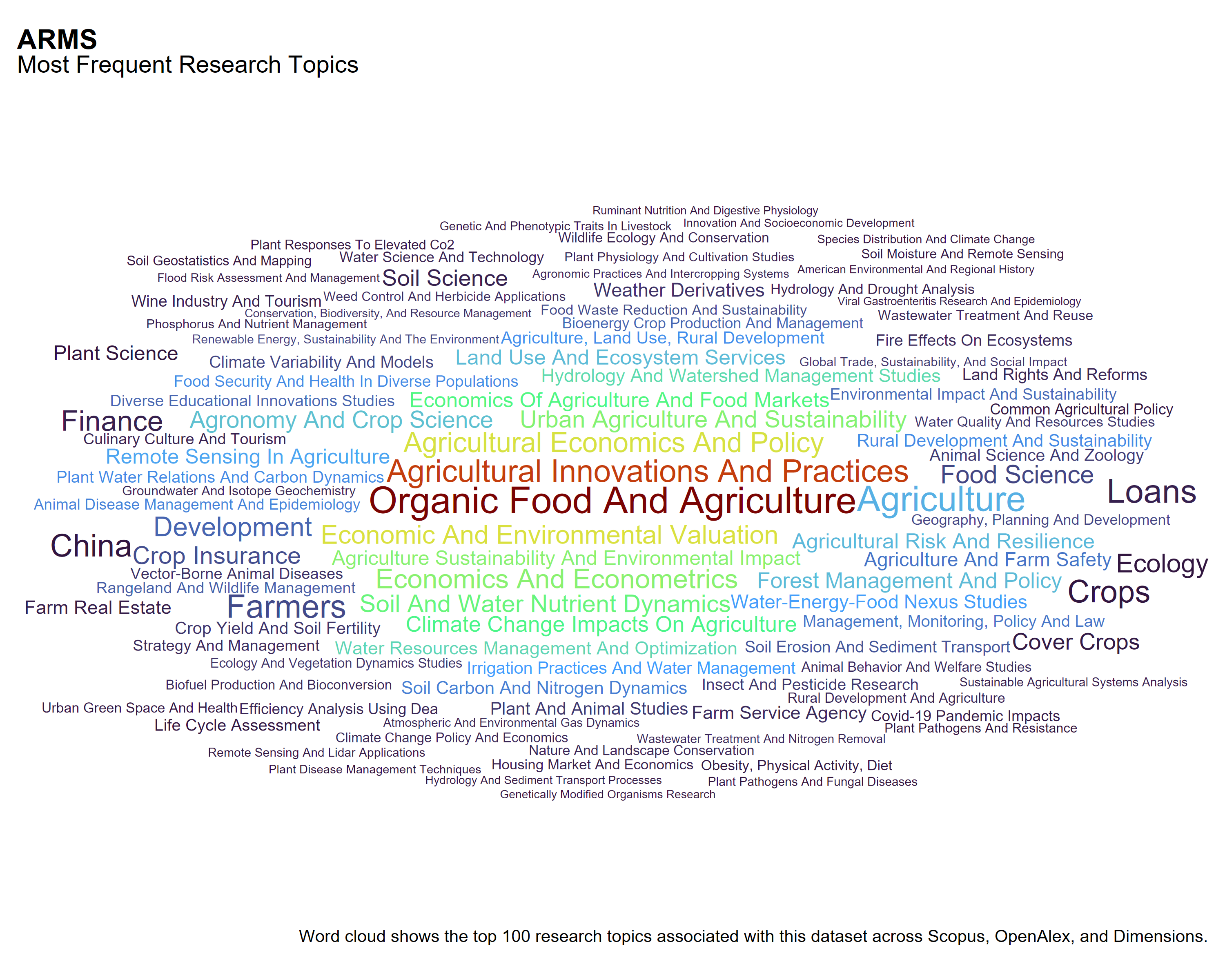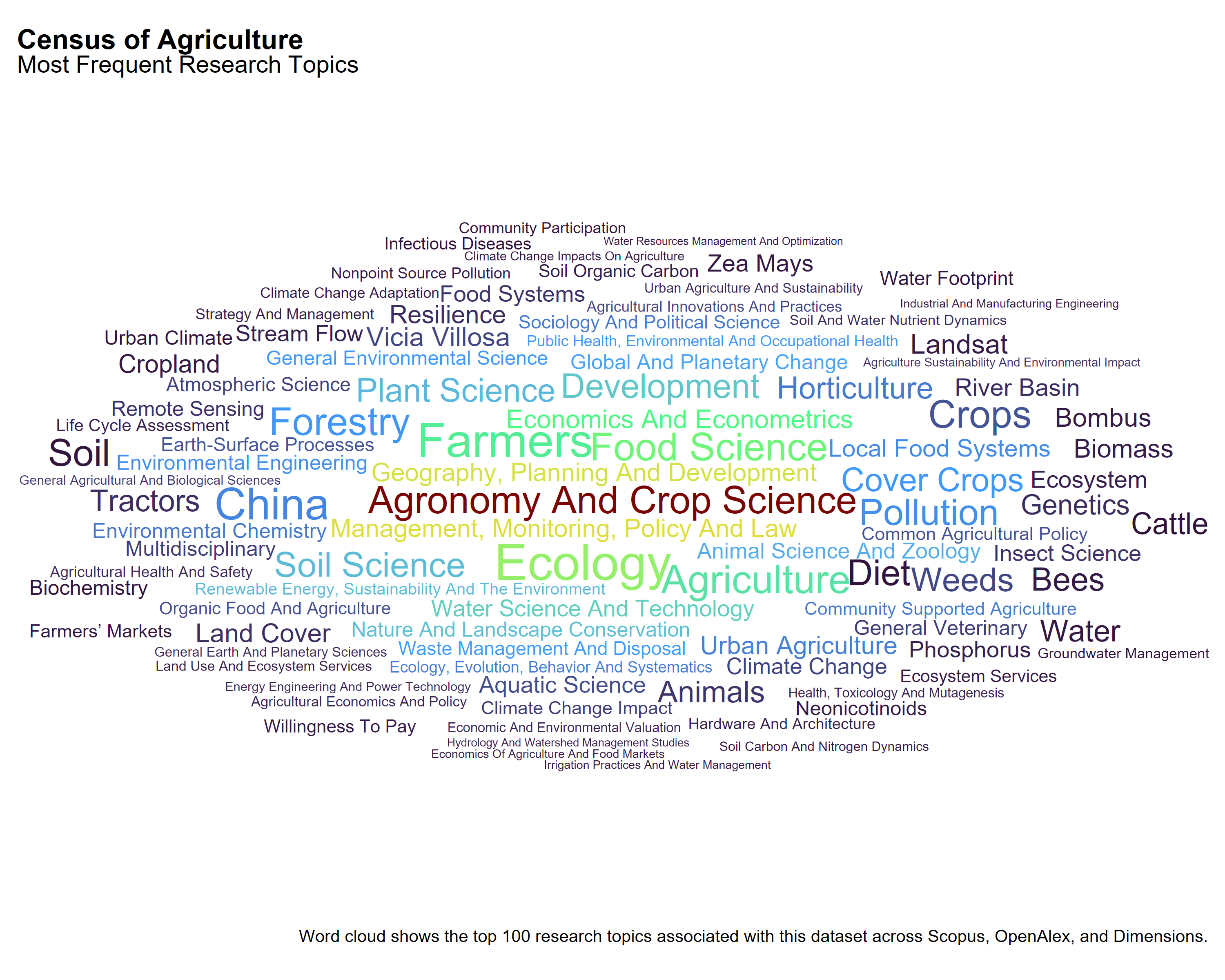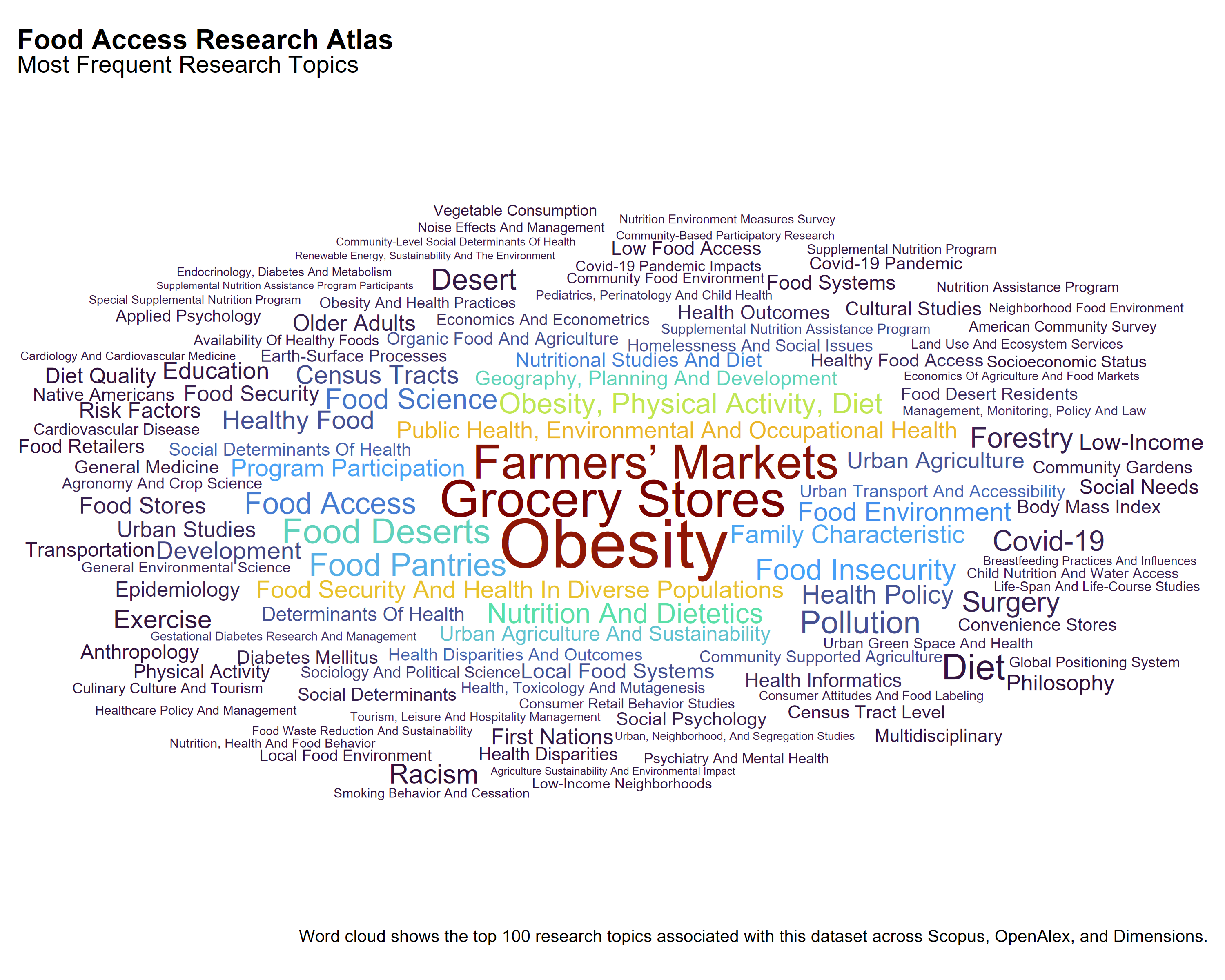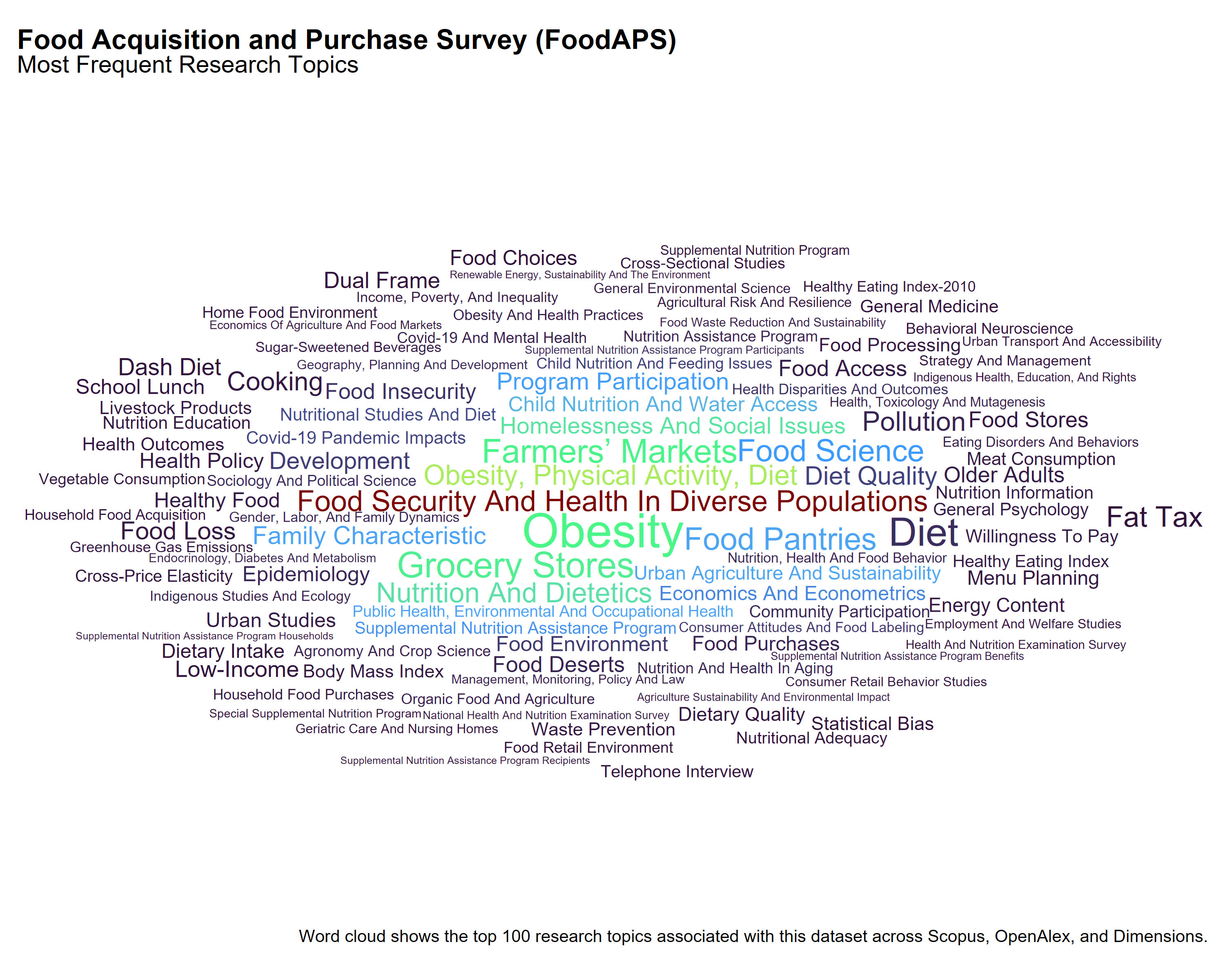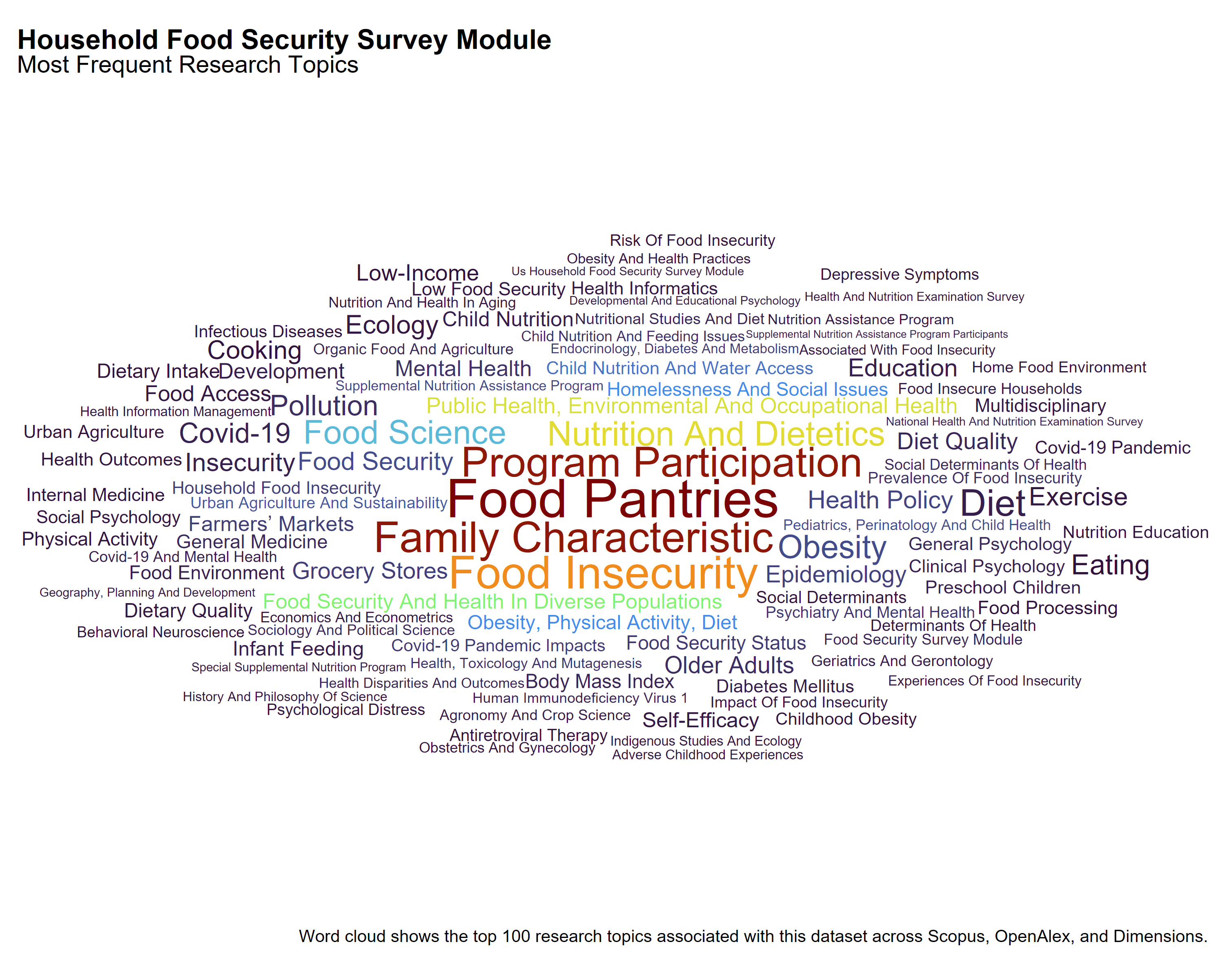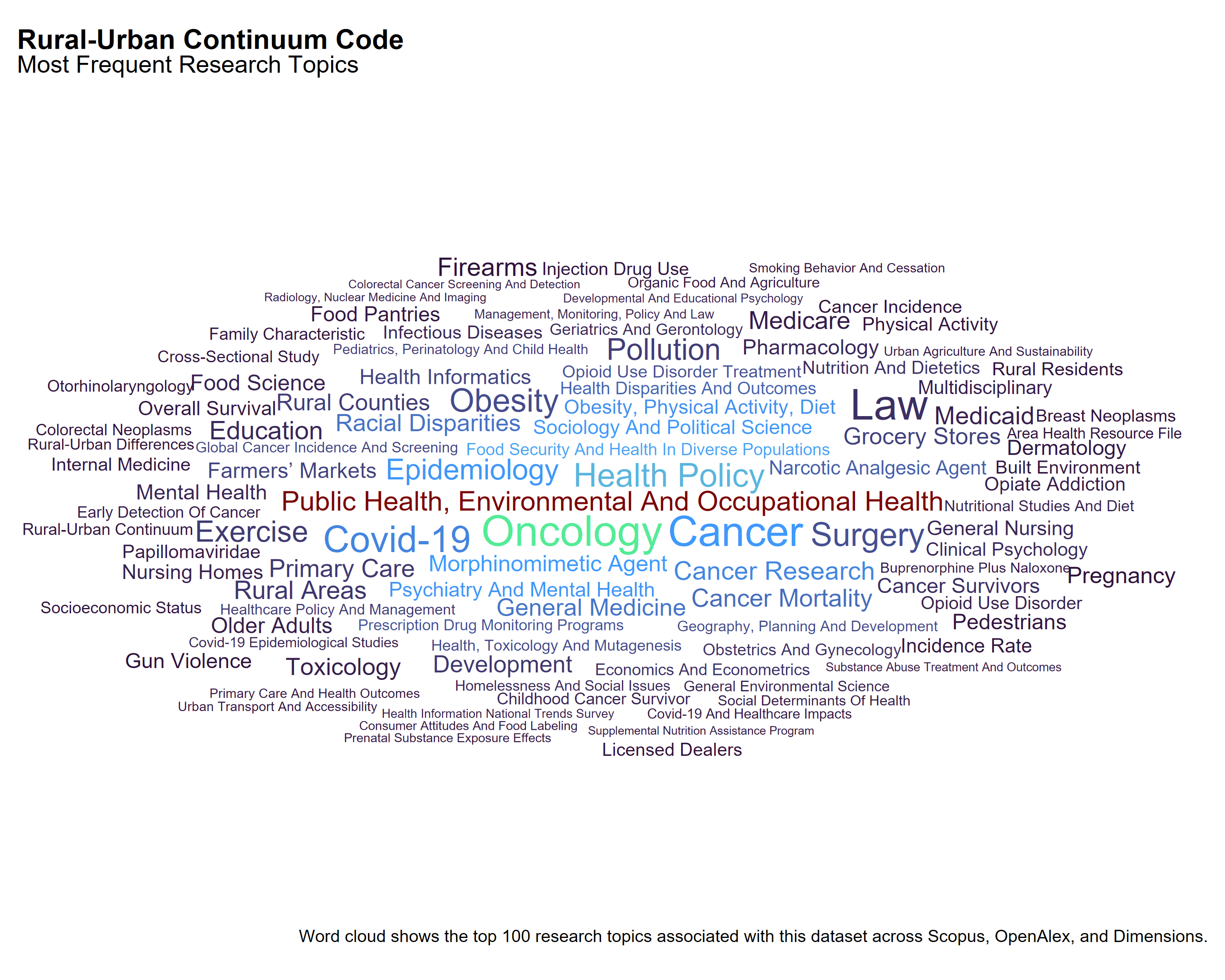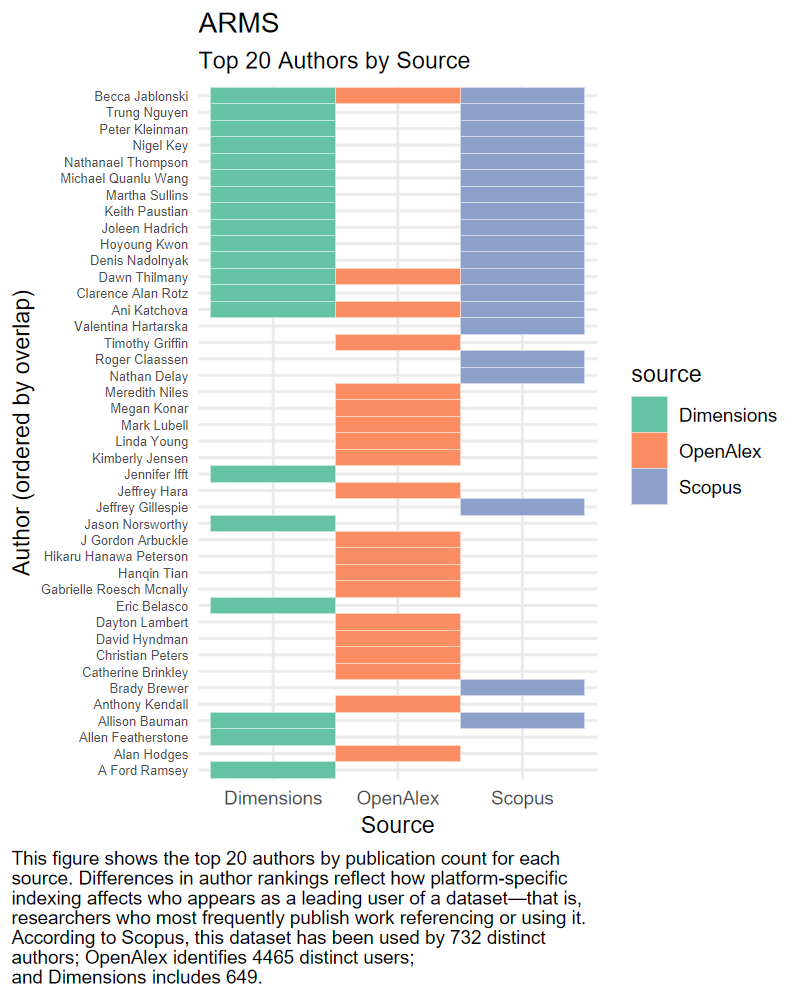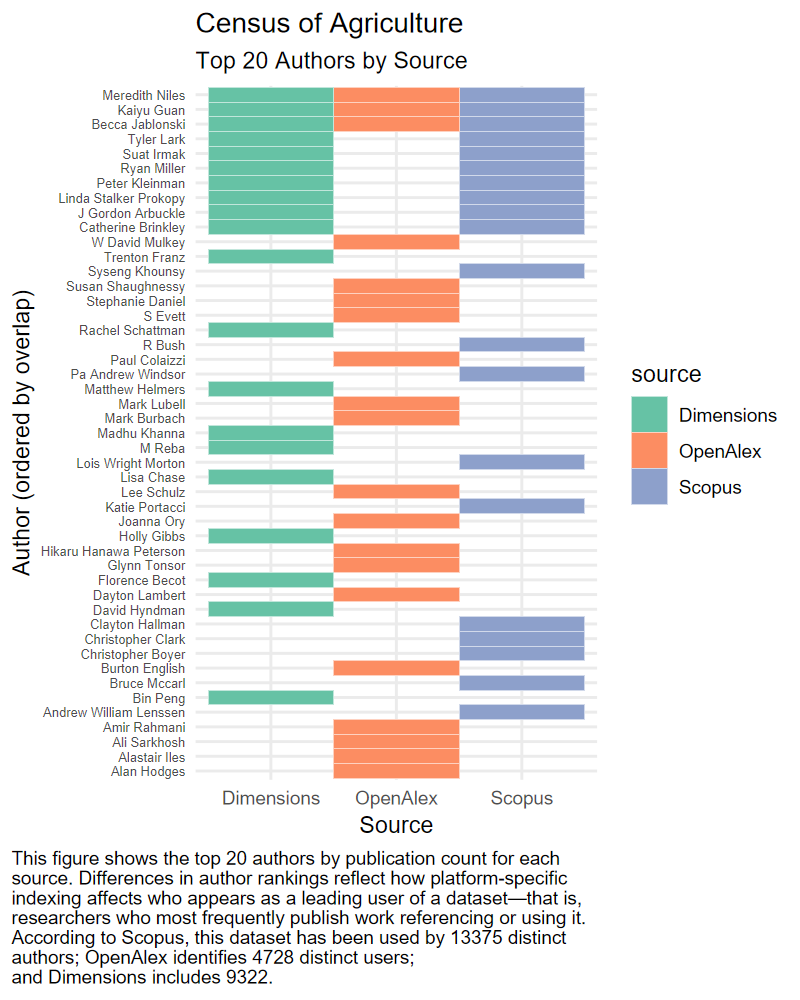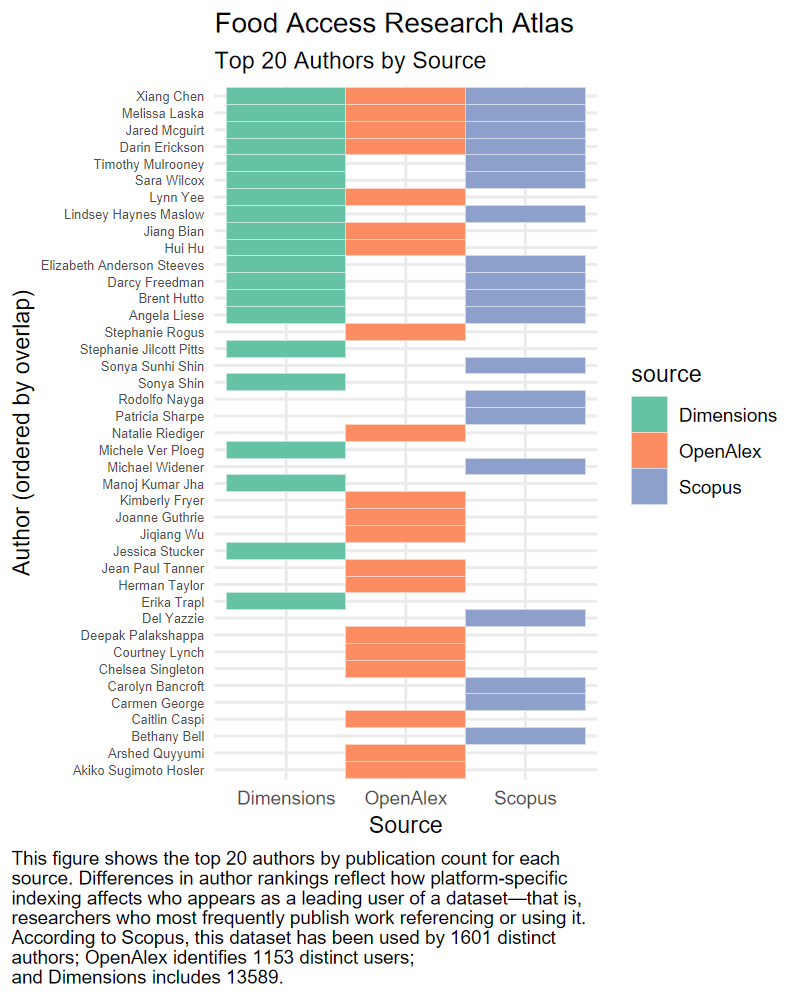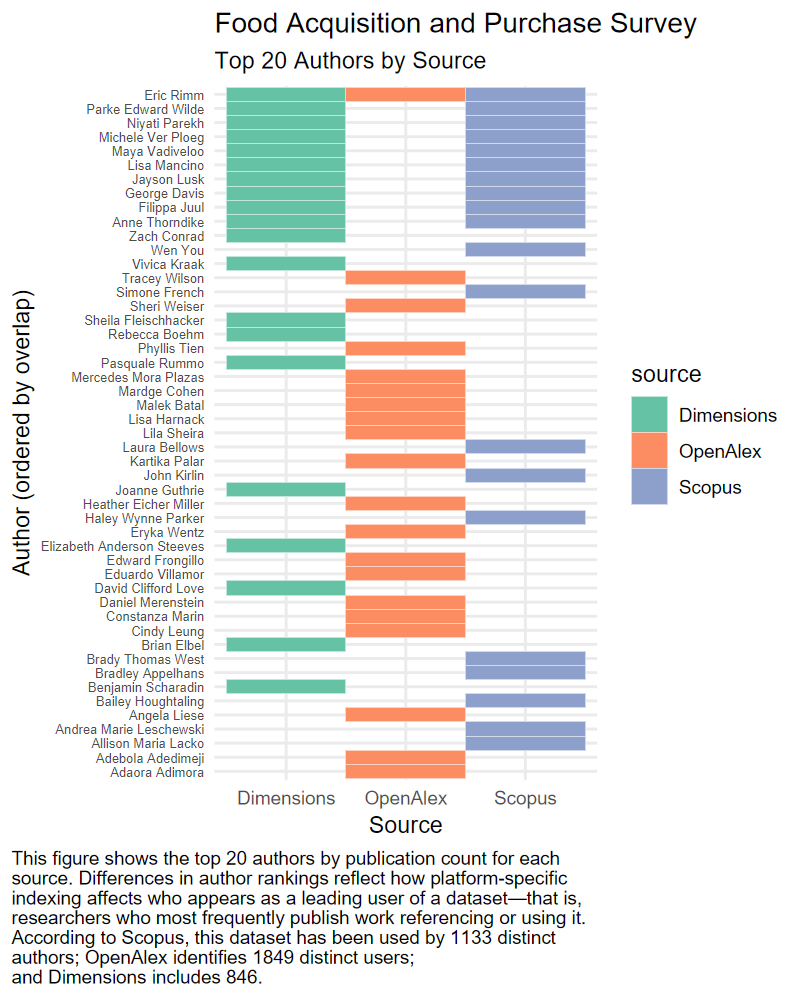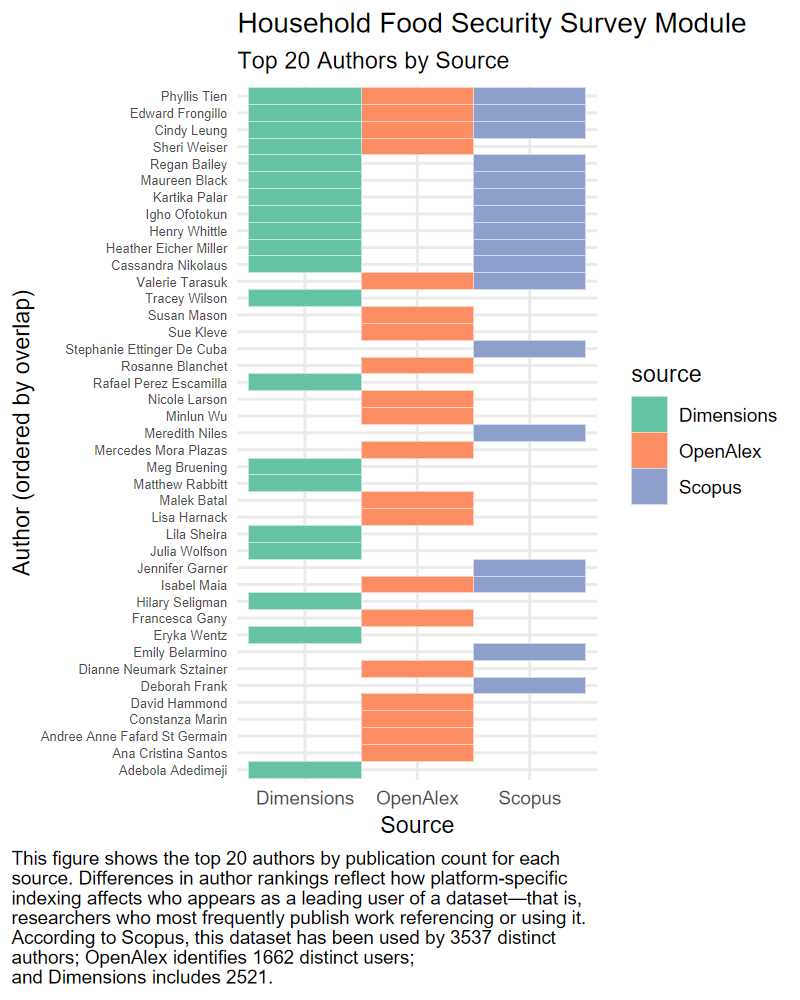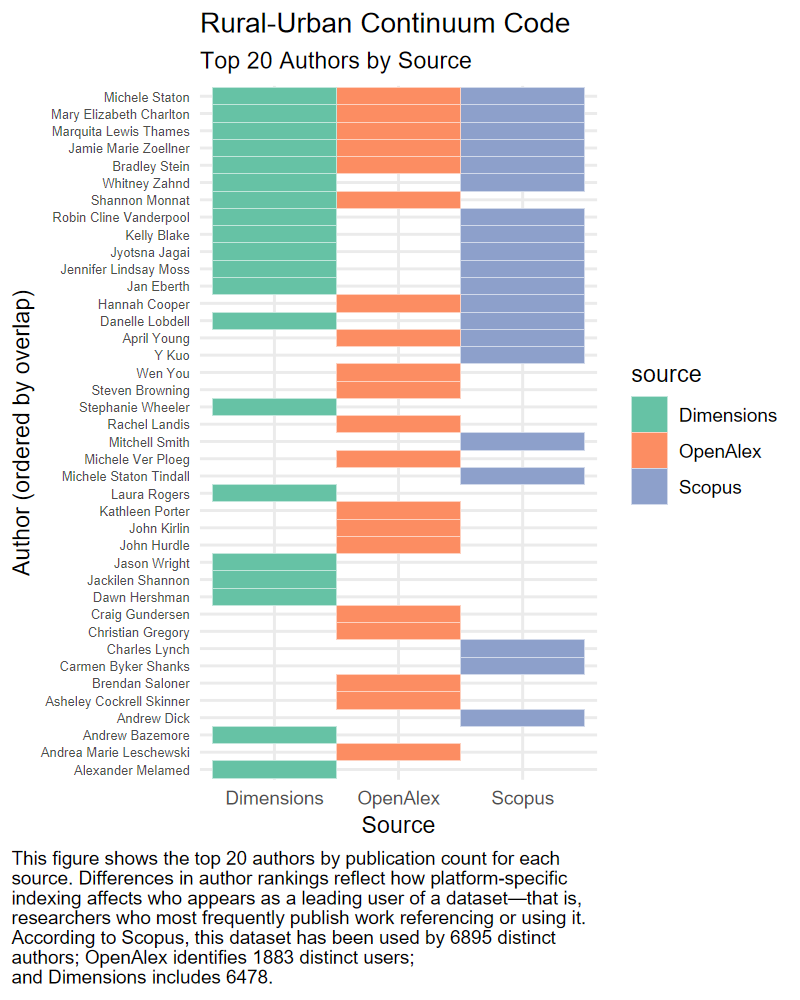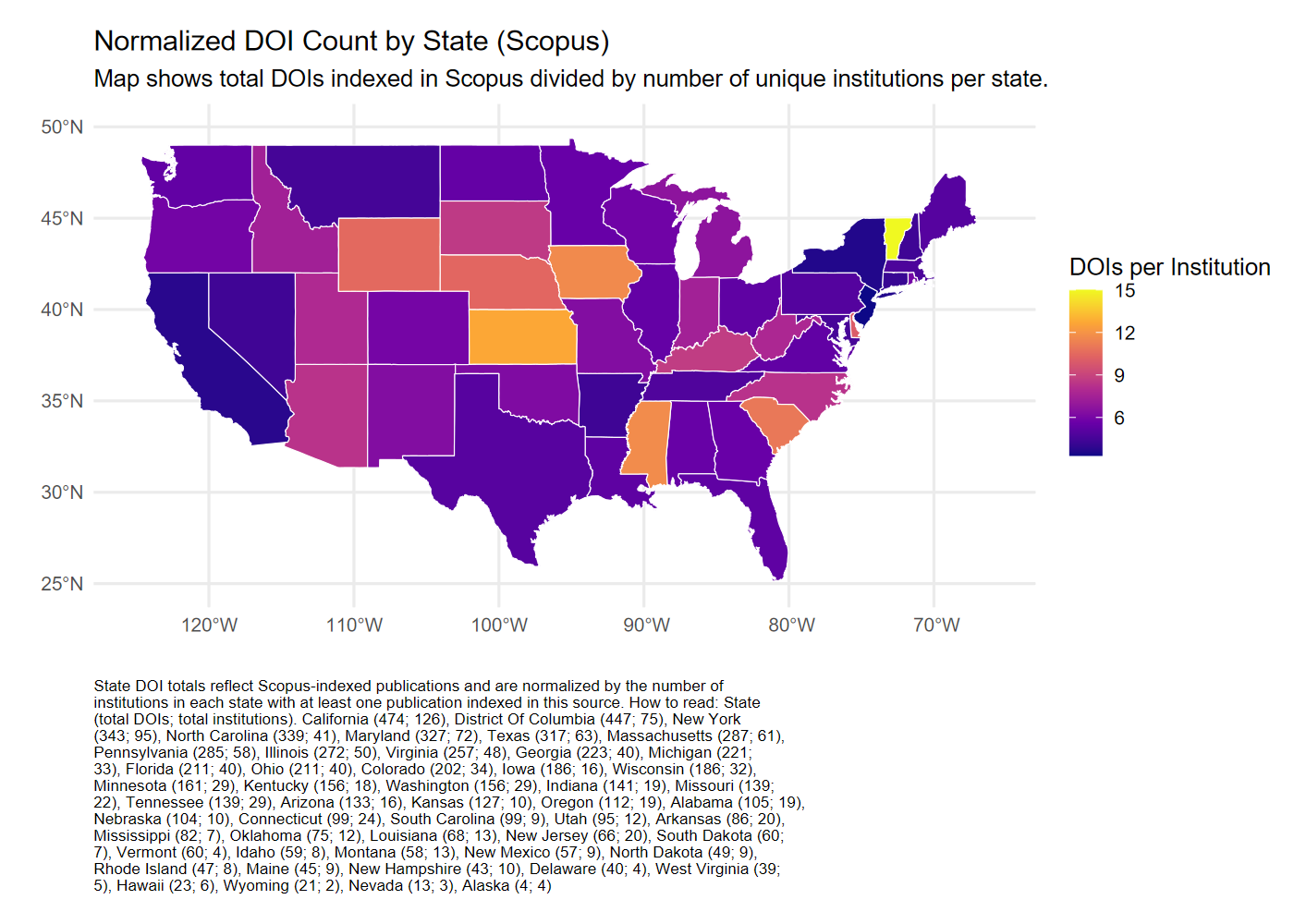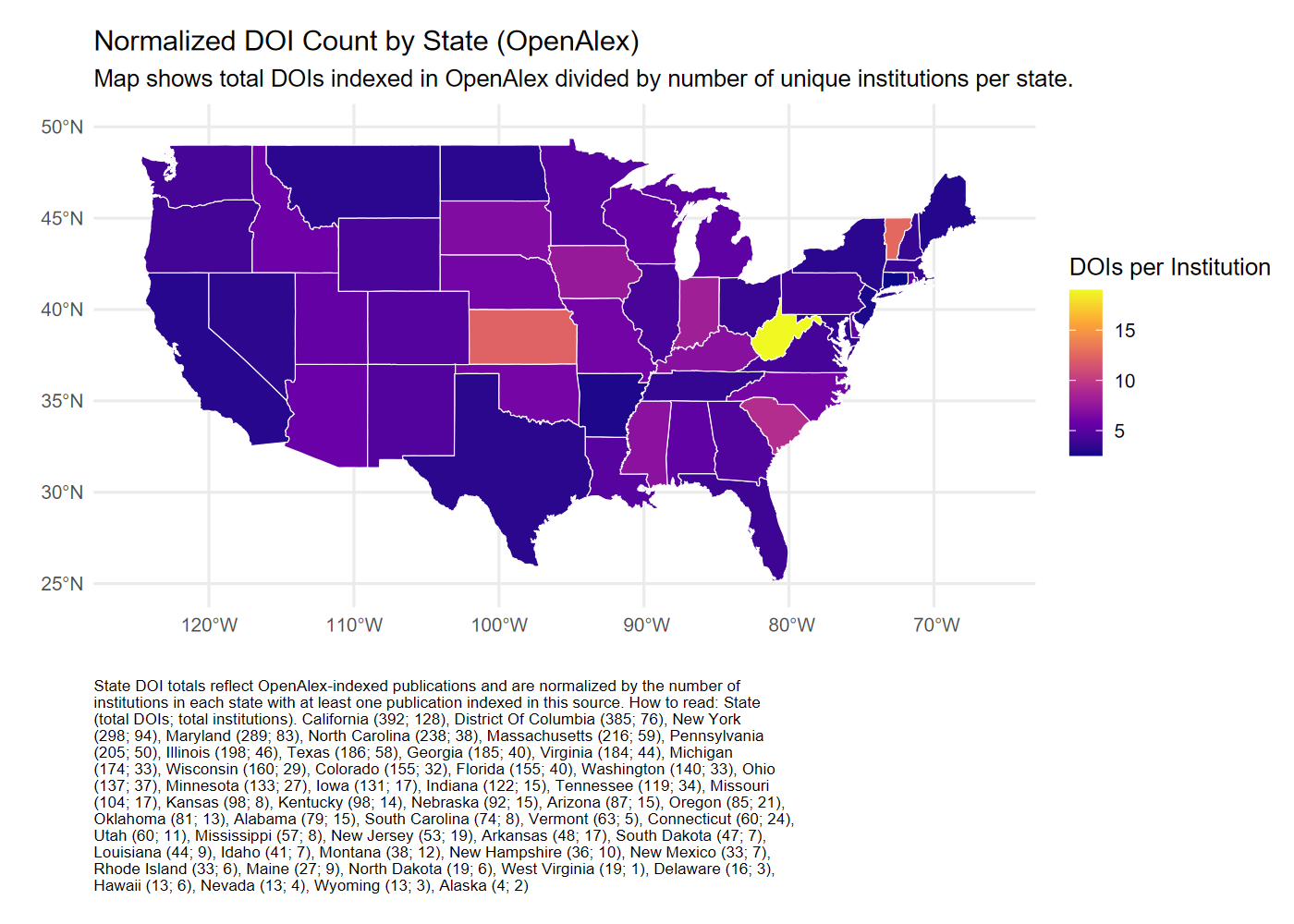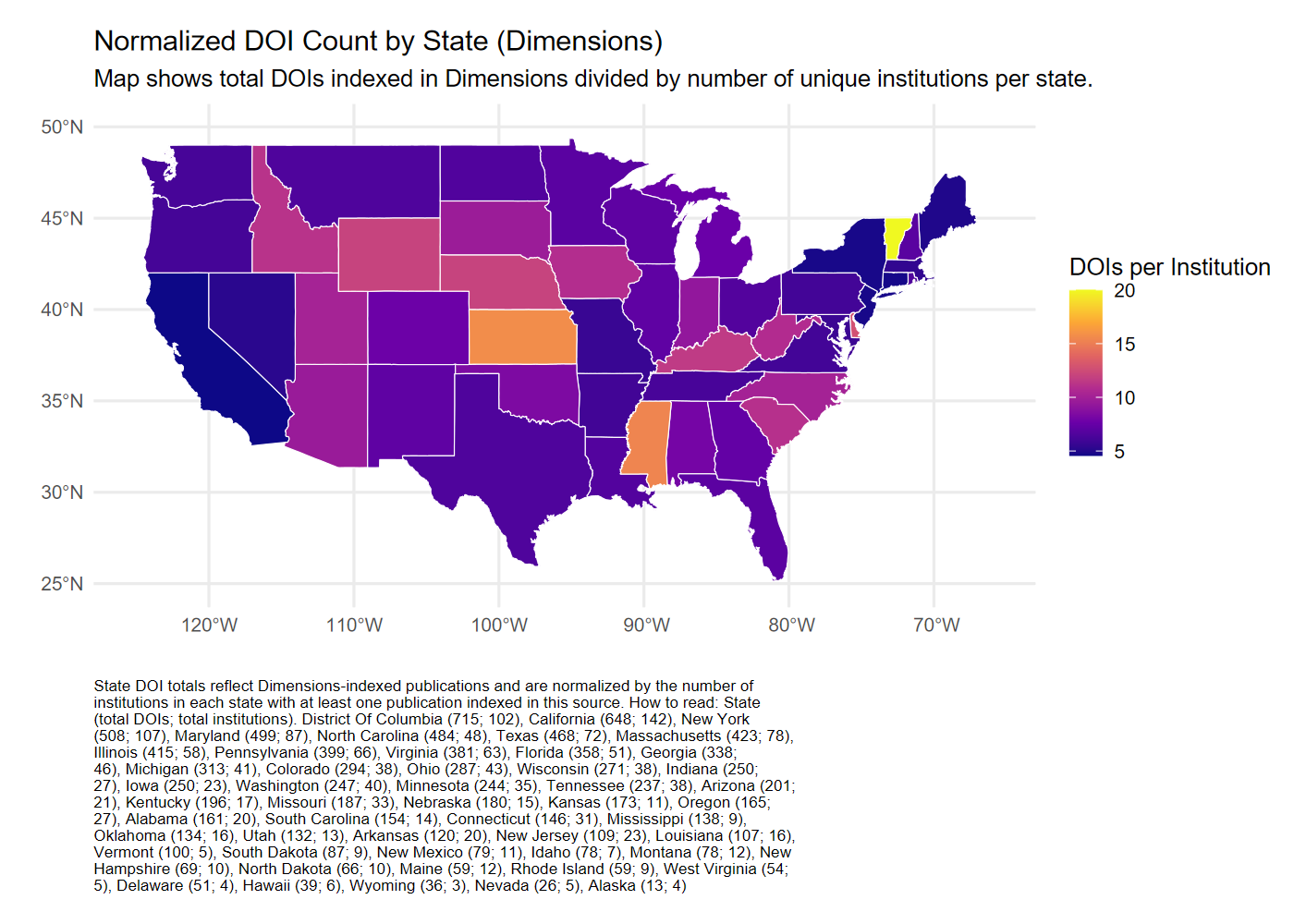Methodology for Comparing Citation Database Coverage of Dataset Usage
Findings
Chenarides, L., Bryan, C., & Ladislau, R. (2025). Methodology for comparing citation database coverage of dataset usage. Available at: https://laurenchenarides.github.io/data_usage_report/report.html
1 Report Summary
What Is the Issue?
Federal datasets play an important role in supporting research across a range of disciplines. Measuring how these datasets are used can help evaluate their impact and inform future data investments. Agencies like the US Department of Agriculture (USDA) track how their datasets are referenced in research papers and disseminate data usage statistics through platforms like Democratizing Data’s Food and Agricultural Research Data Usage Dashboard and NASS’s 5 W’s Data Usage Dashboard. These tools rely on identifying dataset mentions1 in published research to develop usage statistics. Beyond reporting usage statistics, this type of analysis can also provide information about the research topics where federal datasets are applied. Understanding how federal datasets are applied helps characterize their disciplinary reach, including use in areas such as food security, nutrition, and climate, which are inherently multidisciplinary. This informs future work on identifying alternative datasets that researchers use to study similar questions across fields.
The process of identifying dataset mentions in academic research output has two requirements. First, citation databases provide structured access to large volumes of publication metadata, including titles, abstracts, authors, affiliations, and sometimes full-text content. Second, tracking dataset usage requires developing methods that scan publication text for dataset mentions. It is feasible to systematically identify where specific datasets are referenced across a broad set of research outputs by applying machine-learning algorithms to publication corpora collected from citation databases, allowing for scalable search and retrieval of relevant publications where datasets are mentioned. The accuracy of dataset tracking depends on the scope of research output we can access and analyze. However, different databases curate content (i.e., research output) in different ways - some focus on peer-reviewed journals while others include preprints and technical reports - and dataset tracking requires reliable citation data from citation databases.
This report presents a systematic review of identifying dataset mentions in research publications across various citation databases. In doing so, we compare publication, journal, and topic coverage across Scopus, OpenAlex, and Dimensions as primary sources. The purpose is to establish a consistent set of statistics for comparing results and evaluating differences in dataset tracking across citation databases. This allows for insights into how publication scope and indexing strategies influence dataset usage statistics.
How Was the Study Conducted?
Three citation databases are compared: Elsevier’s Scopus, OurResearch’s OpenAlex, and Digital Science’s Dimensions.ai.
Scopus charges for access to its citation database. It indexes peer-reviewed, including journal articles, conference papers, and books, and provides metadata on authorship, institutional affiliation, funding sources, and citations. For this study, Scopus was used to identify dataset mentions through a two-step process: first, Elsevier executed queries against the full-text ScienceDirect corpus and reference lists within Scopus; second, publications likely to mention USDA datasets were filtered based on keyword matching and machine learning models.
OpenAlex, an open-source platform, offers free metadata access. It covers both traditional academic publications and other research outputs like preprints and technical reports. In this study, we used two approaches to identify dataset mentions in OpenAlex: a full-text search, which scans publication metadata fields such as titles and abstracts for references to USDA datasets,2 and a seed corpus search, which starts with a targeted set of publications based on journal, author, and topic criteria, then downloads the full text of each paper to identify mentions of USDA datasets.3
Dimensions, developed by Digital Science, is a citation database that combines free and subscription-based access. It indexes a range of research outputs, including journal articles, books, clinical trials, patents, datasets, and policy documents. Dimensions also links publications to grant and funding information. For this study, publications in Dimensions that reference USDA datasets were identified by constructing structured queries in Dimensions’ Domain Specific Language (DSL) that combined dataset aliases with institutional affiliation terms. These were executed via the
dimcliAPI to return English-language articles from 2017–2023 with at least one U.S.-affiliated author. To maintain consistency with the criteria applied to Scopus and OpenAlex, the study focuses only on publications classified as journal articles.
To compare how these databases track dataset usage, we focus on six USDA datasets commonly used in agricultural, economic, and food policy research:
- Agricultural Resource Management Survey (ARMS)
- Census of Agriculture (Ag Census)
- Rural-Urban Continuum Code (RUCC)
- Food Access Research Atlas (FARA)
- Food Acquisition and Purchase Survey (FoodAPS)
- Household Food Security Survey Module (HHFSS)
These datasets were selected for their policy relevance, known usage frequency, and disciplinary breadth. We developed seed corpora for each dataset to identify relevant publications, then used those corpora to evaluate database coverage, topical scope, and metadata consistency.
What Did the Study Find?
Tracking dataset mentions varies significantly depending on which citation database is used. This analysis compares Scopus, OpenAlex, and Dimensions to determine how each citation database captures research mentioning key USDA datasets. Key findings are detailed below.
1. Publications
Overlap across databases is limited. For most datasets, fewer than 10% of DOIs appear in all three sources. Scopus often identifies the largest share of indexed DOIs, especially for public health–related datasets. OpenAlex captures a broader set of publication types, including preprints and working papers. Dimensions often sits in the middle but includes the highest number of matched DOIs for some datasets.
2. Journals
Scopus emphasizes disciplinary journals, particularly in health, economics, and social science. OpenAlex includes a mix of traditional and nontraditional outlets, including open-access platforms. Dimensions covers many of the same journals as Scopus but with a stronger presence of applied policy and public health titles.
3. Topics
While the same datasets appear across all three sources, the topical classifications differ.
- ARMS is associated with farm management, production economics, and sustainability.
- Census of Agriculture connects to agricultural structure, environmental policy, and rural development.
- Food Access Research Atlas highlights food security, neighborhood-level inequality, and planning.
- FoodAPS centers on household behavior, SNAP, and diet cost.
- HFSSM is tied to poverty, food insecurity, and health disparities.
- RUCC connects to rural healthcare, regional planning, and demographic trends.
Each source applies a different classification system, which affects how these themes are surfaced and grouped.
5. Institutions
Institutional representation varies, with Scopus and Dimensions surfacing more authors from top-tier research universities and federal agencies. OpenAlex includes more community-based organizations and international institutions not always indexed in Scopus.
Evaluating Corpus Coverage Across Sources
Among the three sources examined, Dimensions offered the most consistently structured metadata linking datasets to publications. Its combination of broad journal coverage, funder metadata, and curated topic tags allowed for easier identification of research that referenced USDA datasets, particularly in applied and policy-relevant contexts.
Although Scopus recovered the largest number of publications for certain datasets and fields, and OpenAlex captured a wider range of publication types (including international and open source journals), Dimensions provided the most streamlined path to assembling a usable corpus with fewer manual adjustments. This made it especially useful for mapping the reach of a dataset across disciplines and institutions.
Ultimately, each source contributed unique value to the analysis, and comparing across systems helped surface important differences in coverage and classification.
Takeaway:
No single citation database captures the full scope of research publications referencing USDA datasets. Differences in indexing practices, topic labeling, and metadata structure shape what research is discoverable and how it is interpreted. Among the sources evaluated, Dimensions provided the most consistent, policy-relevant, and accessible view of dataset usage making it a strong candidate for future efforts to track the reach and impact of publicly funded data.
How to Use This Report
This report outlines an initial approach for characterizing how USDA-related food and agriculture datasets are referenced in research publications indexed by Scopus, OpenAlex, and Dimensions. The work is not peer-reviewed but is fully transparent and reproducible, with all underlying code and procedures available for verification and reuse.
The report includes methods for:
- Identifying publication coverage across citation databases
- Cross-referencing dataset mentions across sources
- Analyzing research topics, institutional affiliations, and author networks
Reusable components produced as part of this effort include:
- A code repository for data cleaning and standardization
- A crosswalk of data schemas by citation database
The general framework developed here can be extended to other citation systems, including Web of Science, Crossref, and Microsoft Academic, for similar evaluations of dataset coverage and usage.
2 Full Report
2.1 Project Background
Tracking how federal datasets are used in academic research has been a priority for agencies such as the U.S. Department of Agriculture (USDA). Democratizing Data’s Food and Agricultural Research (FAR) Data Usage Dashboard was developed to support this effort by identifying and counting publications referencing USDA datasets. Initially built on Scopus, a proprietary citation database with structured indexing and reliable metadata, the dashboard faced limitations due to access costs and restricted journal availability.
As interest in open-access infrastructure has grown, OpenAlex, a free and open-source citation database developed by OurResearch, has emerged as a potential alternative. OpenAlex offers broad coverage of research outputs, including preprints and conference proceedings, and has attracted attention as a scalable replacement for proprietary systems. However, switching platforms raises questions about coverage completeness, data reliability, and how well each database supports transparent monitoring of dataset use.
In parallel with this evaluation, a new partnership was formed with Digital Science, the developers of Dimensions. Dimensions offers a hybrid model of free and subscription-based services and provides API access that facilitates structured identification of dataset mentions. Compared to other platforms, Dimensions includes grant metadata, standardized topic taxonomies, and curated dataset linkages, helping overcome several limitations identified in Scopus and OpenAlex.
Although USDA discontinued its direct support for the dashboard, this work was taken up by the National Data Platform as part of a broader effort to build trusted infrastructure for data-driven research. To inform this transition, a systematic comparison was conducted across Scopus, OpenAlex, and Dimensions to assess their relative strengths for tracking dataset usage in food and agricultural research. The goal was not to endorse a single platform, but to provide a transparent and replicable framework for evaluating citation data quality, coverage, and relevance for public data monitoring.
2.1.1 Project Objective
This report presents a method for tracking how six key USDA datasets (Table 1) are mentioned in research using Scopus, OpenAlex, and Dimensions. It identifies where each dataset appears, which topics they are used in, which authors and institutions are most active, and how these patterns vary depending on the citation database. The findings reveal how differences in database coverage and classification can affect assessments of dataset use.
2.1.2 Specific Aims
This section outlines the core objectives guiding the database comparison and the steps used to determine how well each citation platform captures publications that mention key USDA datasets.
Evaluate differences in publication coverage across citation databases. Measure the extent to which Scopus, OpenAlex, and Dimensions capture research publications that reference USDA datasets. Identify how publication inclusion varies across platforms.
Compare journal indexing and scope. Compare the journals indexed by each database and examine how differences in journal coverage influence visibility of dataset-linked research.
Analyze topic coverage. Examine the research areas where USDA datasets are mentioned. Identify patterns in topic classification and assess how different citation databases support subject-level tracking of dataset usage.
Evaluate author representation. Compare how author names are recorded across platforms, including the completeness of author metadata and potential implications for attribution and visibility.
Examine institutional representation. Evaluate how each platform captures and standardizes institutional affiliations. Pay particular attention to differences in coverage for Minority-Serving Institutions (MSIs), land-grant universities, and other public or underrepresented institutions.
Develop a reproducible methodology for cross-platform comparison. Create a generalizable workflow for comparing citation databases, including steps for record linkage, deduplication, author and institution standardization, and identification of dataset mentions.
The methodology described in this report provides a systematic approach for comparing publication coverage where federal datasets are mentioned across citation databases. The scope of work includes comparing publication coverage across Scopus, OpenAlex, and Dimensions. For more information on the metadata available from each citation database, refer to this Appendix. These methods can be applied to other citation databases as alternatives to current data sources.
2.2 Data Collection
A core objective of this study is to evaluate publication coverage across citation databases, focusing on how well Scopus, OpenAlex, and Dimensions index research relevant to food and agricultural research. A targeted strategy was used to identify publications referencing USDA datasets, aligning with federal agency efforts to monitor and report on dataset usage. This approach enables a consistent entry point for comparison across platforms while also providing insight into the topics where federal datasets are applied and the use of complementary or alternative data sources.
To support this analysis, a structured inventory of USDA data assets was developed, drawing from records produced by the Economic Research Service (ERS) and the National Agricultural Statistics Service (NASS). From this broader inventory, six datasets were selected for detailed comparison based on known usage, policy relevance, and disciplinary breadth: the Census of Agriculture, Agricultural Resource Management Survey (ARMS), Food Acquisition and Purchase Survey (FoodAPS), Food Access Research Atlas (FARA), Rural-Urban Continuum Code (RUCC), and the Household Food Security Survey Module (HFSSM). The set of data assets, their producing agencies, and descriptions are presented in Table 1.
| Dataset Name | Produced By | Description |
|---|---|---|
| Census of Agriculture | NASS | Conducted every five years, it provides comprehensive data on U.S. farms, ranches, and producers. |
| Agricultural Resource Management Survey (ARMS) | ERS | A USDA survey on farm financials, production practices, and resource use. |
| Food Acquisition and Purchase Survey (FoodAPS) | ERS | A nationally representative survey tracking U.S. household food purchases and acquisitions. |
| Food Access Research Atlas (FARA) | ERS | A USDA tool mapping food access based on store locations and socioeconomic data. |
| Rural-Urban Continuum Code (RUCC) | ERS | A classification system distinguishing U.S. counties by rural and urban characteristics. |
| Household Food Security Survey Module | ERS | A USDA survey module used to assess food insecurity levels in households. |
Researchers reference datasets in inconsistent ways—using acronyms, abbreviations, alternate spellings, or related URLs. To capture these variations, we created a structured list of dataset–alias pairs, called dyads. This Appendix provides the full list of dyads used to search for mentions of each USDA dataset across Scopus, OpenAlex, and Dimensions. This list ensures consistent and comprehensive identification of dataset mentions in research publications.
Using these dyads, we applied tailored search strategies across each citation database to identify relevant publications for all six datasets. These included a seed search in Scopus, a full-text metadata search in OpenAlex, a seed corpus approach in OpenAlex based on targeted filtering of journals, authors, and topics followed by full-text analysis, and a full-text search in Dimensions. Each search strategy is described in detail in the following sections.
2.2.1 Scopus Approach
The first citation database used is Scopus, a publication catalog managed by Elsevier. Ideally, direct Scopus API access would have been used to query full publication text for mentions of USDA datasets. However, the project did not have access to the Scopus API. Only Elsevier, serving as a project partner, was able to execute queries within the Scopus environment. Consequently, the dataset mention search relied on outputs provided by Elsevier rather than independent querying.
Because of these constraints, a seed corpus approach was applied. First, Elsevier matched the names and aliases of all USDA datasets against full-text records available through ScienceDirect and reference sections of Scopus publications published between 2017 and 2023. This initial step identified journals, authors, and topics most likely to mention USDA datasets. A targeted search corpus was then constructed, narrowing the scope to approximately 1.45 million publications. These included various document types—articles, reviews, short surveys, notes, conference papers, chapters, books, editorials, letters, data papers, errata, and tombstones. For the purposes of this comparative report, only articles are considered.
Several methods were used to identify mentions of USDA datasets in Scopus publications. First, a reference search was conducted, using exact-text matching across publication reference lists to capture formal citations of datasets. Second, full-text searches were performed using machine learning models applied to publication bodies, identifying less formal mentions of datasets. Third, machine learning routines developed through the 2021 Kaggle competition were applied to the full-text corpus to improve detection of dataset mentions, including instances where references were indirect or less structured. Details about the three machine learning models used are available here.
Because direct access to full publication text was not available, Elsevier shared only the extracted snippets and limited metadata. Manual validation, aided by the use of keyword flags (e.g., “USDA,” “NASS”), confirmed whether identified mentions accurately referred to the targeted datasets. To manage validation costs, only publications with at least one U.S.-based author were reviewed.
Full documentation of the Scopus search routine, including query construction and extraction procedures, is available in this appendix..
2.2.2 OpenAlex Approach
The second citation database used is OpenAlex, an open catalog of scholarly publications that provides public acess to metadata and, when available, full-text content for open-access publications via its API. Unlike Scopus, which provides controls access to licensed content, OpenAlex indexes only open-access publications or those for which open metadata has been made available by publishers.
Two methods were used to identify USDA dataset mentions in OpenAlex: a full-text search and a seed corpus approach. Both methods focused on peer-reviewed journal articles published between 2017 and 2023 and restricted the dataset to final published versions, excluding preprints and earlier drafts to avoid duplication across versions.
Method 1: Full-Text Search
This method relied on querying OpenAlex’s full-text search index using combinations of dataset aliases (e.g., alternate names, acronyms) and institutional flag terms (e.g., “USDA,” “NASS”). The combination of dataset alias and flag terms ensured that retrieved publications made an explicit connection to the correct data source. A “true” dataset mention was recorded only when at least one alias and one flag term appeared in the same publication, increasing the precision of captured dataset mentions.4
Queries were implemented using the pyalex Python package5, which manages API requests and enforces OpenAlex’s usage rate limits. The search used the search and filter endpoints, targeting English-language, open-access articles or reviews published after 2017. Results were returned in JSON format based on the OpenAlex Work object schema, including fields for publication metadata, authorship, journal, concepts, citations, and open access status. Each record included metadata fields such as:
display_name(publication title)authorships(authors and affiliations)host_venue.display_name(journal)doi(digital object identifier)concepts(topics)cited_by_count(citation counts)type(publication type, e.g., “article”)publication_year(year article was publish)language(language, English only)is_oa(open access)
Full documentation of the OpenAlex search routine, including query construction and extraction procedures, is available in this appendix..
Limitations of Full-Text Search Method
Although the OpenAlex API provides access to full-text search, limitations in content ingestion affect result completeness. OpenAlex receives publication text through two primary ingestion methods: PDF extraction and n-grams delivery.
In the PDF ingestion method, OpenAlex extracts text directly from the article PDF. However, the references section is not included in the searchable text. References are processed separately to create citation pointers between scholarly works, meaning that mentions of datasets appearing only in bibliographies are not discoverable through full-text search.
In the n-grams ingestion method, OpenAlex does not receive the full article text. Instead, it receives a set of extracted word sequences (n-grams) from the publisher or author. These n-grams represent fragments of text—typically short sequences of one, two, or three words—which are not guaranteed to preserve full continuous phrases. As a result, complete dataset names may be broken apart or omitted, reducing the likelihood that search queries match the intended aliases.
These ingestion and indexing limitations affect the completeness of results when relying solely on OpenAlex full-text search. Mentions of USDA datasets that appear either exclusively in references or are fragmented within n-grams may be missed. To address these limitations, an alternative search method was developed based on constructing a filtered seed corpus of publications for local full-text analysis.
Method 2: Seed Corpus
To overcome the limitations of the full-text metadata search, a seed corpus approach was developed. This method created a filtered subset of publications for local full-text analysis, targeting likely mentions of USDA datasets.
Selection criteria for the seed corpus included:
- English-language publications
- Works published between 2017-2023
- Publication Type = articles
- Open-access publications only
To focus the sample, we used results from the initial OpenAlex full-text search to identify the top 25 journals, authors, and topics most frequently associated with USDA dataset mentions. For each entity, we computed a Full-Text Search Count, which is the number of publications where USDA datasets were explicitly mentioned in the full text. This metric reflects how often each topic, journal, or author has appeared in USDA dataset–relevant research.
We then filtered the broader OpenAlex catalog to include all publications—regardless of whether they mentioned a dataset—linked to these top-ranked entities. This allowed us to build a more focused but expansive corpus for local text search. By narrowing to 25 entities per category, we prioritized relevance while managing scale. This process generated a structured set of JSON files containing publication metadata and links. The Python script used to flatten and process these files is provided in this appendix.
Example: Census of Agriculture
To illustrate this process, consider the tables created for the Census of Agriculture dataset—Table 4 (top 25 topics), Table 5 (top 25 journals), and Table 6 (top 25 U.S.-affiliated authors). Each table contains two columns:
- Full-Text Search Count: Number of publications from the OpenAlex full-text search that mention the dataset and are linked to the given topic, journal, or author
- Total Count: Total number of publications in OpenAlex associated with that topic, journal, or author, regardless of dataset mention
The Full-Text Search Count helps us identify which entities are most directly associated with USDA dataset use. For instance, if a topic like “Impact of Food Insecurity on Health Outcomes” has 78 dataset-related publications. This count reflects how often USDA datasets were mentioned within the full text of publications associated with a particular entity. Meanwhile, the OpenAlex Total Count shows the broader publication volume for that topic—in this case, over 78,000—providing context on how prominent the topic is within the full OpenAlex database. In this sense, the Full-Text Search Count serves as a rough proxy for market penetration, or how frequently a dataset appears within a given research area relative to the total volume of publications.
The Full-Text Search Count reflects how often USDA datasets are explicitly mentioned within a specific research area, while the Total Count represents the overall volume of publications linked to that topic, journal, or author. The large gap between these counts was a key reason for developing the seed corpus approach: even within high-relevance entities, many publications may reference datasets in ways not captured by OpenAlex’s full-text search.
By downloading and analyzing the full texts of all publications linked to the entities in the second column, we applied our own string-matching logic to detect mentions that OpenAlex’s indexing may have missed, particularly in reference sections or when dataset names were fragmented. This allowed us to validate and extend OpenAlex search results using a consistent and transparent local method.
This approach has several implications. It increases the relevance of the corpus by focusing on publications where USDA datasets are actively cited, rather than broadly associated with a topic. It also reduces processing demands by avoiding the need to download all potentially relevant PDFs. However, by prioritizing high-visibility entities from the initial search, the method may introduce selection bias and miss less frequently cited but still relevant work. The trade-off reflects a practical balance between analytical depth and operational feasibility.
For the Census of Agriculture, the resulting seed corpus included approximately 1.77 million unique publications. About 35% of full texts were successfully downloaded, yielding an estimated 625,000 documents for local analysis. Full-text searches on this subset improved detection of dataset mentions beyond what OpenAlex’s native indexing allowed.
Despite the benefits, limitations remain. Full-text availability was constrained by broken or inaccessible links, and processing the corpus was computationally intensive. Future work may require distributed processing or more refined filters to improve efficiency.
The table below summarizes primary differences between the Full-Text Search and Seed Corpus methods. The Full-Text Search provides broader initial coverage, but it is limited by indexing constraints and lack of reference section access. The Seed Corpus narrows the search space but allows for deeper, locally controlled analysis of full-text content, including citations.
| Feature / Criterion | Full-Text Search | Seed Corpus |
|---|---|---|
| Searchable Sample | OpenAlex API where has_fulltext = true |
Curated list based on known users/sources |
| Source of text | Article body or word/phrase snippets where fulltext_origin = n-grams |
Any part of publication conditional on available PDF download |
| Reference sections indexed? | No | Yes. Will include publications that reference datasets in citations. |
Full text required? (has_fulltext) |
Yes | Not required |
Open access required? (is_oa) |
No | Yes. Method requires downloading the full PDF version of the article. |
| Selection criteria | None imposed a priori | Journal/topic/author targeting |
| Resulting sample | Broad, but with limitations | Narrower, given the target search criteria |
2.2.3 Dimensions
To identify publications mentioning USDA datasets, we used the Dimensions.ai API, following the same general methodology applied in Scopus and OpenAlex. We reused the same dataset aliases, institutional flag terms, and overall search criteria to ensure consistency across sources. The search covered scholarly publications from 2017 to 2023 and was restricted to works authored by at least one researcher affiliated with a U.S.-based institution.
Dimensions queries are written using a structured Domain Specific Language (DSL). We constructed boolean queries that combined multiple dataset aliases (e.g., “NASS Census of Agriculture”, “USDA Census”, “Agricultural Census”) with institutional identifiers (e.g., “USDA”, “NASS”, “U.S. Department of Agriculture”). As with Scopus and OpenAlex, both a dataset alias and an institutional flag term were required to appear in each result. These terms were grouped using OR within each category and then combined with an AND across categories. For example:
(“NASS Census of Agriculture” OR “Census of Agriculture” OR “USDA Census of Agriculture” OR “Agricultural Census” OR “USDA Census” OR “AG Census”) AND (USDA OR “US Department of Agriculture” OR “United States Department of Agriculture” OR NASS OR “National Agricultural Statistics Service”)
We implemented this process using the dimcli Python library, which provides a streamlined interface to the Dimensions.ai API and automates result pagination. A significant advantage of this approach is the capability of the Dimensions.ai platform to manage complex searches directly, resulting in precise results and reduced computational overhead. By executing these queries directly through the API, we avoided the technical complexity associated with downloading and locally processing large amounts of textual content. Moreover, the Dimensions.ai API results can be automatically structured into an analysis-ready DataFrame format. This simplified data structure greatly facilitated our subsequent validation, data integration, and analytical workflows.
To maintain methodological consistency with Scopus and OpenAlex, the following filters were applied to the search:
- English-language publications
- Works published between 2017-2023
- Document types: articles, chapters, proceedings, monographs, and preprints
- Author affiliations: Publications were filtered to include only those authored by researchers affiliated with at least one U.S.-based institution.
For comparability with the Scopus and OpenAlex samples, only publications classified as “articles” were retained for final analysis. This restriction reduces duplication across versions (e.g., preprints, proceedings) and reflects our focus on peer-reviewed scholarly output.
For each article, we retrieved metadata including title, authors, DOI, journal, abstract, publication date, citation counts, subject classifications, and links. These fields supported topic-level analysis, author and institution mapping, and validation of dataset mentions.
Using Dimensions.ai provided two main technical advantages. First, because the platform supports full-text query execution natively, we avoided the need to download or parse external files. Second, the API responses were easily converted into analysis-ready DataFrames, which simplified downstream validation and integration with other sources.
Overall, the Dimensions.ai approach aligned with our methods for Scopus and OpenAlex, enabling consistent identification of USDA dataset mentions across all three platforms.
2.2.4 Data Processing
To produce a consistent count of unique publications referencing each USDA dataset, records from three sources-Scopus, OpenAlex, and Dimensions-were consolidated, each of which identified publications through a different mechanism, described above.
For each source, publication-level metadata, including DOIs, journal titles, ISSNs (when available), and source-specific topic classifications was extracted. DOIs were standardized (e.g., removing URL prefixes, https://doi.org/) for consistent matching across sources. Duplicate DOIs within each source were removed. All DOIs compared in this report are associated with publications classified as document type = article and were published between 2017 and 2023.
2.3 Results
The aims described in Section 2.1.2 guide the development of a methodology for comparing citation databases, focusing on four areas:
Publication tracking: Comparing how each platform captures publications within indexed journals
Journal coverage: Determining which journals each platform indexes
Topic scope: Evaluating the research areas of publications that cite USDA datasets
Author and institutional affiliation: Determining how each platform records institutional information
Processed publication metadata was then merged across sources using the cleaned DOI-ISSN pairs as the common identifier. Each publication was tagged with binary indicators showing whether it appeared in Scopus, OpenAlex Full Text, OpenAlex Seed, or some combination thereof. When metadata overlapped (such as journal titles or publication years), Scopus information was prioritized, when available, given its relatively higher metadata quality, followed by OpenAlex Full Text, OpenAlex Seed, and then Dimensions.6
This process ensured that each publication was counted once, even if it appeared in multiple sources. The final dataset includes a deduplicated set of DOIs, along with harmonized metadata and source indicators. The number of unique publications referencing each dataset is shown in Table 3.
| Dataset Name | Number of Unique Publications |
|---|---|
| ARMS | 1,581 |
| Census of Agriculture | 5,835 |
| Food Access Research Atlas | 590 |
| Food Acquisition and Purchase Survey | 808 |
| Household Food Security Survey Module | 1,408 |
| Rural-Urban Continuum Code | 2,215 |
All code used to clean, deduplicate, and merge records is provided in the GitHub repository.
2.3.1 Publication Coverage
An objective of this report is to understand differences in publication coverage across Scopus, OpenAlex, and Dimensions. Specifically, this section asks: (1) how many and which publications referencing USDA datasets appear in each citation database, and (2) how many and which journals publishing these articles overlap between the two sources.
In addition, the analysis evaluates whether the different search strategies used in OpenAlex—the full-text metadata search versus the seed-corpus approach—yield substantially different sets of results.
For each of the six USDA datasets (Table 1) featured in this study, a treemap visualization summarizes publication coverage across the three citation databases. Each treemap groups publications into mutually exclusive categories based on their presence in one or more of the sources. The size of each box is proportional to the number of distinct DOIs in that group, providing a visual summary of relative coverage. For example, a large “Scopus only” segment indicates a high number of publications indexed exclusively in Scopus, while overlapping segments (e.g., “Scopus ∩ Dimensions”) reflect shared coverage between platforms.
Agricultural Resource Management Survey (ARMS)
OpenAlex dominates coverage for ARMS-related publications, capturing nearly 76% of all distinct DOIs exclusively. In contrast, Scopus and Dimensions contribute relatively little: just 8.9% and 5.6% of DOIs appear exclusively in those sources, respectively. Overlaps are modest, with 2.5% of DOIs shared by OpenAlex and Dimensions, and only 1.9% captured by all three. This suggests OpenAlex’s broader indexing of ARMS publications relative to the other databases.
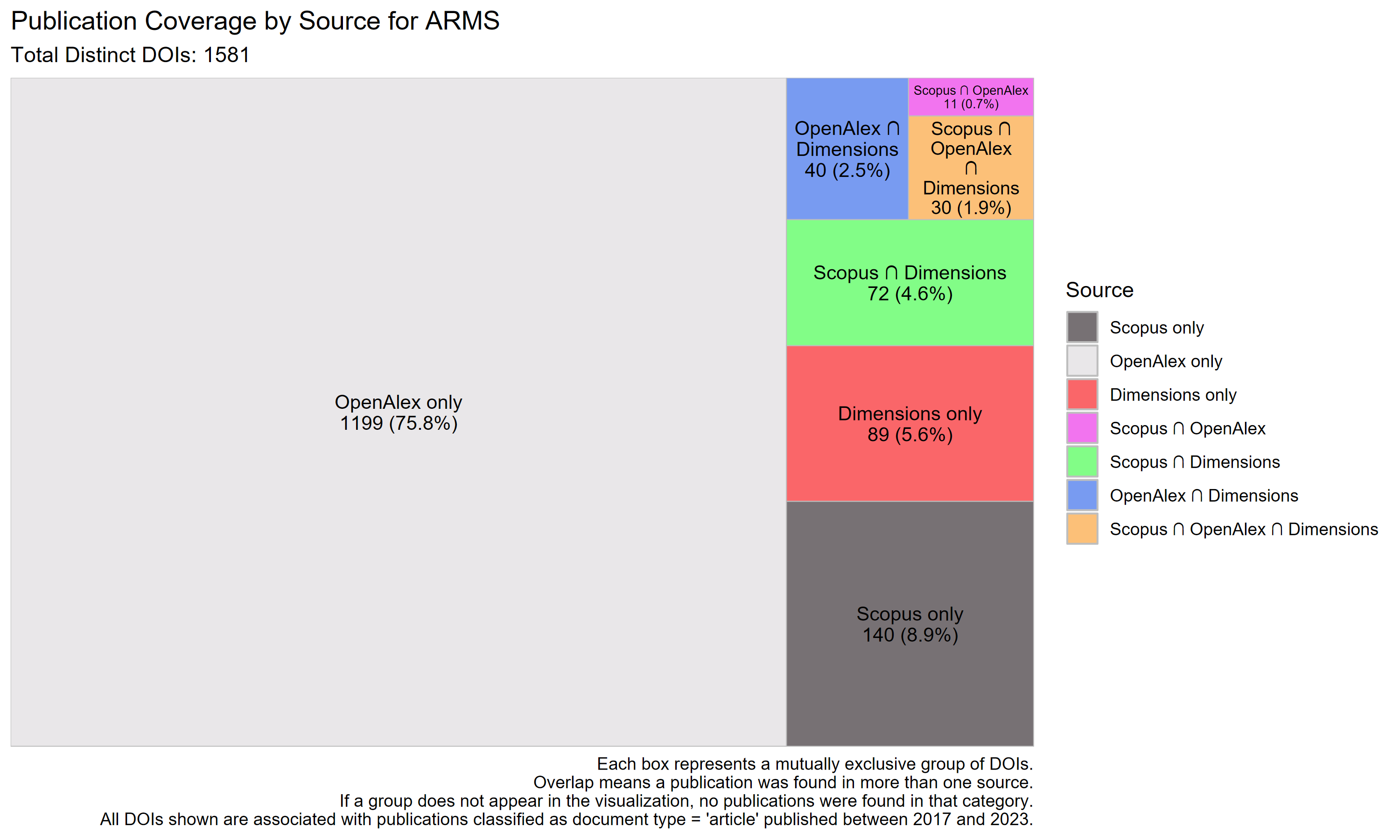
The Census of Agriculture
Scopus provides the broadest exclusive coverage for the Census of Agriculture, accounting for 41.3% of DOIs. Dimensions follows at 18.8%, while OpenAlex accounts for just 9.2% exclusively. The largest overlap is between Scopus and Dimensions (22.8%), with limited three-way overlap (3.6%). These results indicate that Scopus and Dimensions are the primary sources capturing publications referencing this dataset.
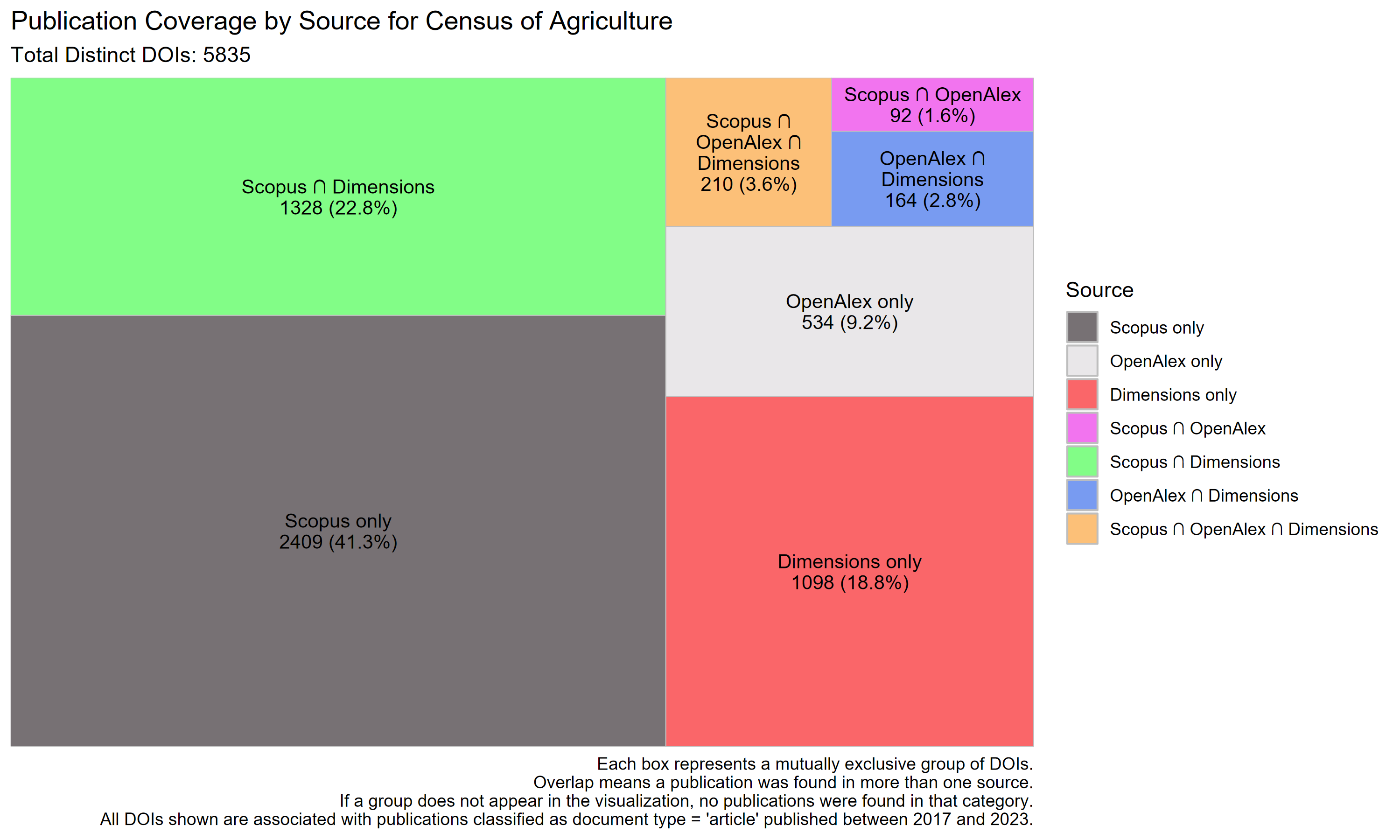
Food Access Research Atlas
Coverage for this dataset is more evenly distributed. Scopus and Scopus ∩ Dimensions each account for about 24%, while OpenAlex-only coverage is 14.6%, and Dimensions-only is 11.9%. Notably, 11% of DOIs appear in all three sources. This more balanced distribution suggests broader and more consistent indexing across platforms, without a single source dominating.
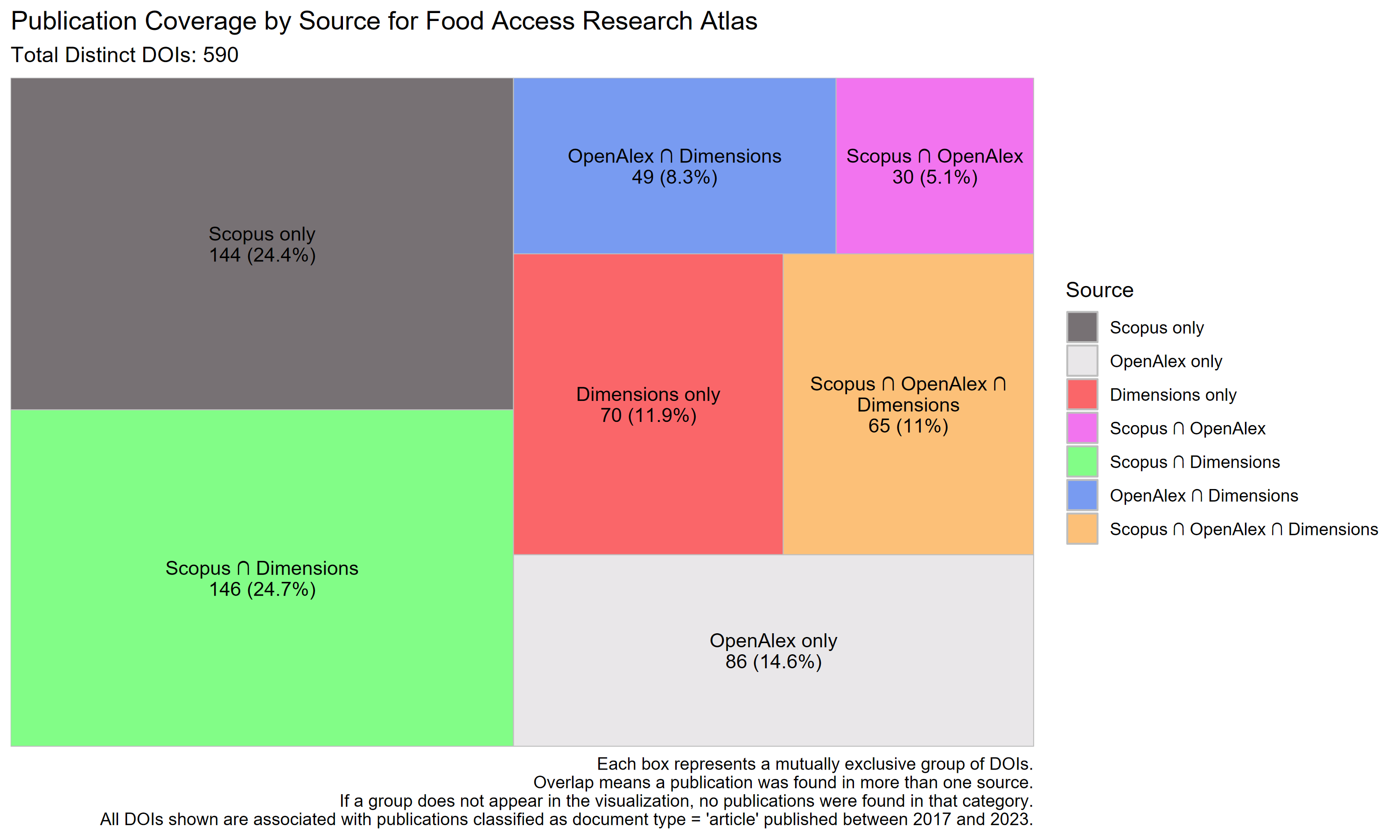
The Food Acquisition and Purchase Survey (FoodAPS)
OpenAlex again provides the widest exclusive coverage (46.7%), while Scopus and Scopus ∩ Dimensions each contribute 17.8%. Dimensions-only coverage is modest (7.7%), and 4.7% of DOIs are shared across all three. This indicates that OpenAlex is especially important for capturing FoodAPS-related work, but combined use of all three sources increases overall visibility.

The Household Food Security Survey Module
Scopus has the highest exclusive coverage (34.7%), followed by Scopus ∩ Dimensions (22.3%) and Dimensions-only (17.5%). OpenAlex-only coverage is lower at 12.8%, and just 5.8% of DOIs are indexed by all three. This indicates stronger coverage for HFSSM-related publications in Scopus and Dimensions compared to OpenAlex.
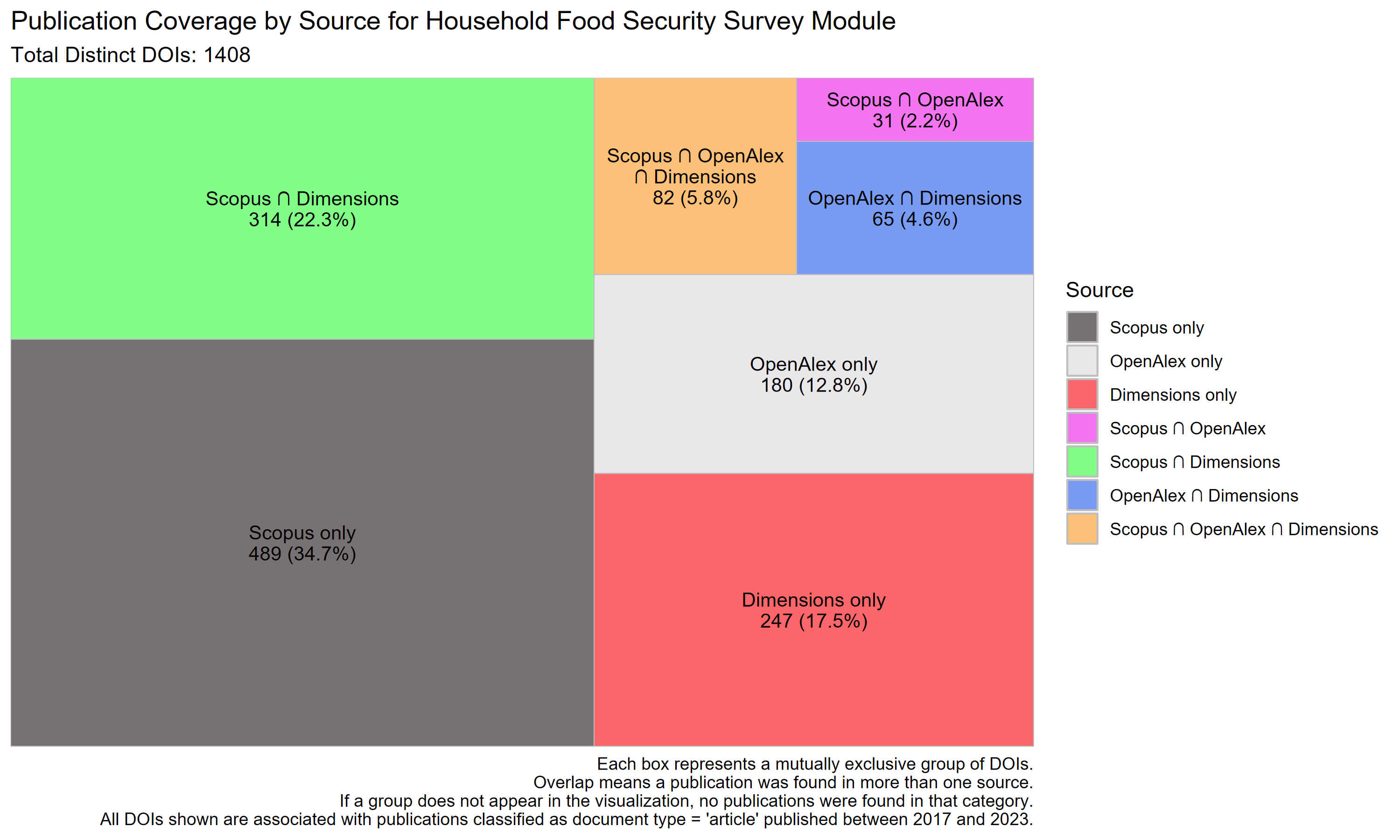
Rural-Urban Continuum Code
Coverage is again led by Scopus (30.8%) and Dimensions (25%), with Scopus ∩ Dimensions contributing another 24.2%. OpenAlex-only coverage is relatively low at 8.1%, and only 5.9% of DOIs are shared across all three. This pattern is consistent with datasets where OpenAlex’s coverage is more limited.
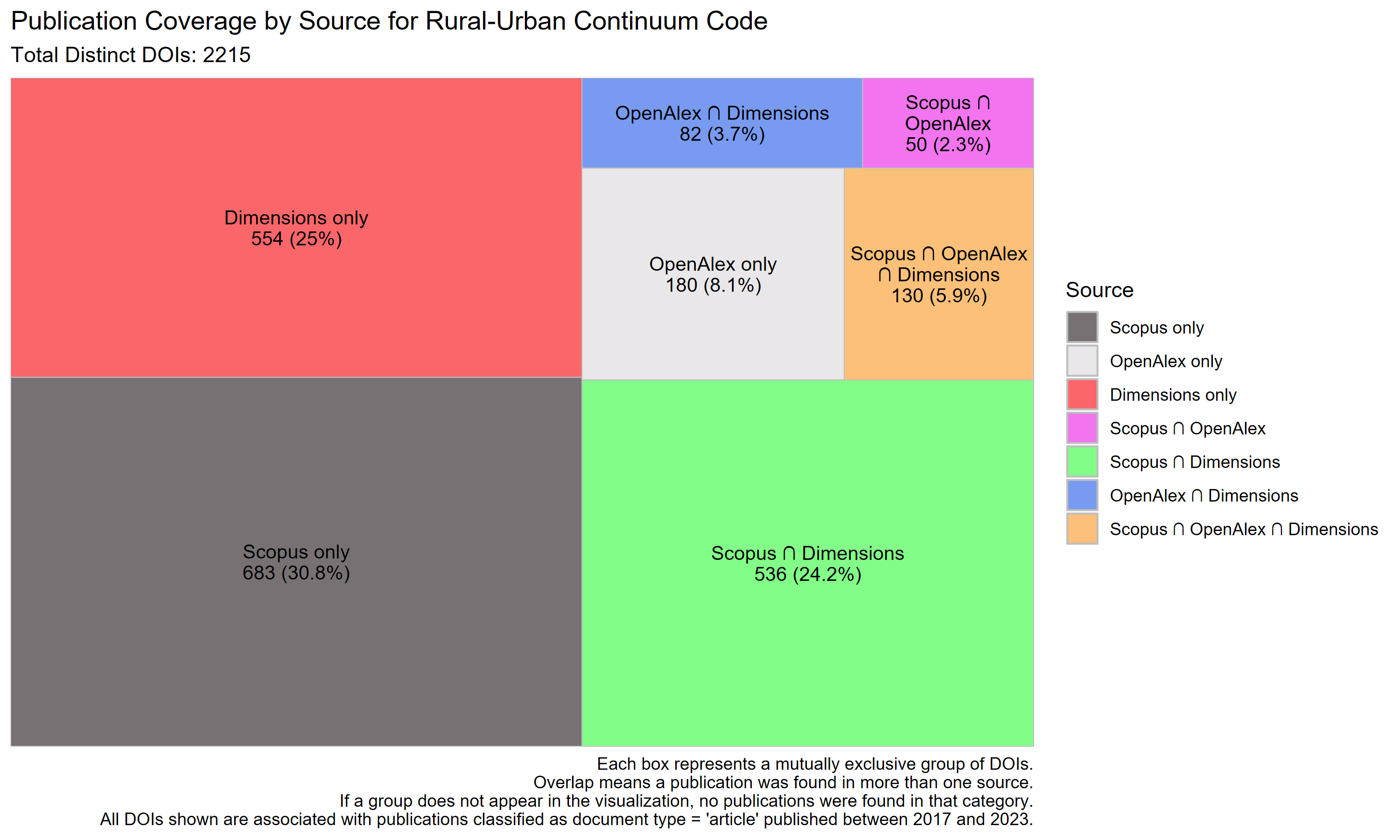
| Dataset | Total DOIs | Scopus only (%) | OpenAlex only (%) | Dimensions only (%) | Scopus ∩ OpenAlex (%) | Scopus ∩ Dimensions (%) | OpenAlex ∩ Dimensions (%) | All three (%) |
|---|---|---|---|---|---|---|---|---|
| ARMS | 1581 | 8.9 | 75.8 | 5.6 | 0.7 | 4.6 | 2.5 | 1.9 |
| Census of Agriculture | 5835 | 41.3 | 9.2 | 18.8 | 1.6 | 22.8 | 2.8 | 3.6 |
| Food Access Research Atlas | 590 | 24.4 | 14.6 | 11.9 | 5.1 | 24.7 | 8.3 | 11.0 |
| FoodAPS | 808 | 17.8 | 46.7 | 7.7 | 1.7 | 17.8 | 3.6 | 4.7 |
| HFSSM | 1408 | 34.7 | 12.8 | 17.5 | 2.2 | 22.3 | 4.6 | 5.8 |
| RUCC | 2215 | 30.8 | 8.1 | 25.0 | 2.3 | 24.2 | 3.7 | 5.9 |
2.3.2 Journal Coverage
The previous section documented substantial variation in publication coverage across Scopus, OpenAlex, and Dimensions. One potential explanation for these differences is variation in journal indexing across sources. This section examines that possibility by looking at journal coverage, specifically, whether each citation database indexes the journals where USDA dataset-related publications appear.
For each dataset, the analysis identifies the top 40 journals (by DOI count) and determines which citation databases index them. Sankey diagrams illustrate the relationship between citation databases (left) and journals (right). Flows indicate coverage, with journals indexed in multiple sources connected to each. While only the top 40 journals are visualized, a complete list is available in the GitHub repository.
Agricultural Resource Management Survey (ARMS)
Most top journals referencing ARMS are indexed by OpenAlex, including several high-DOI outlets such as Applied Economic Perspectives and Policy and the American Journal of Agricultural Economics. Fewer journals are exclusive to Scopus or Dimensions. This pattern aligns with OpenAlex’s dominant coverage of ARMS publications in the previous section.
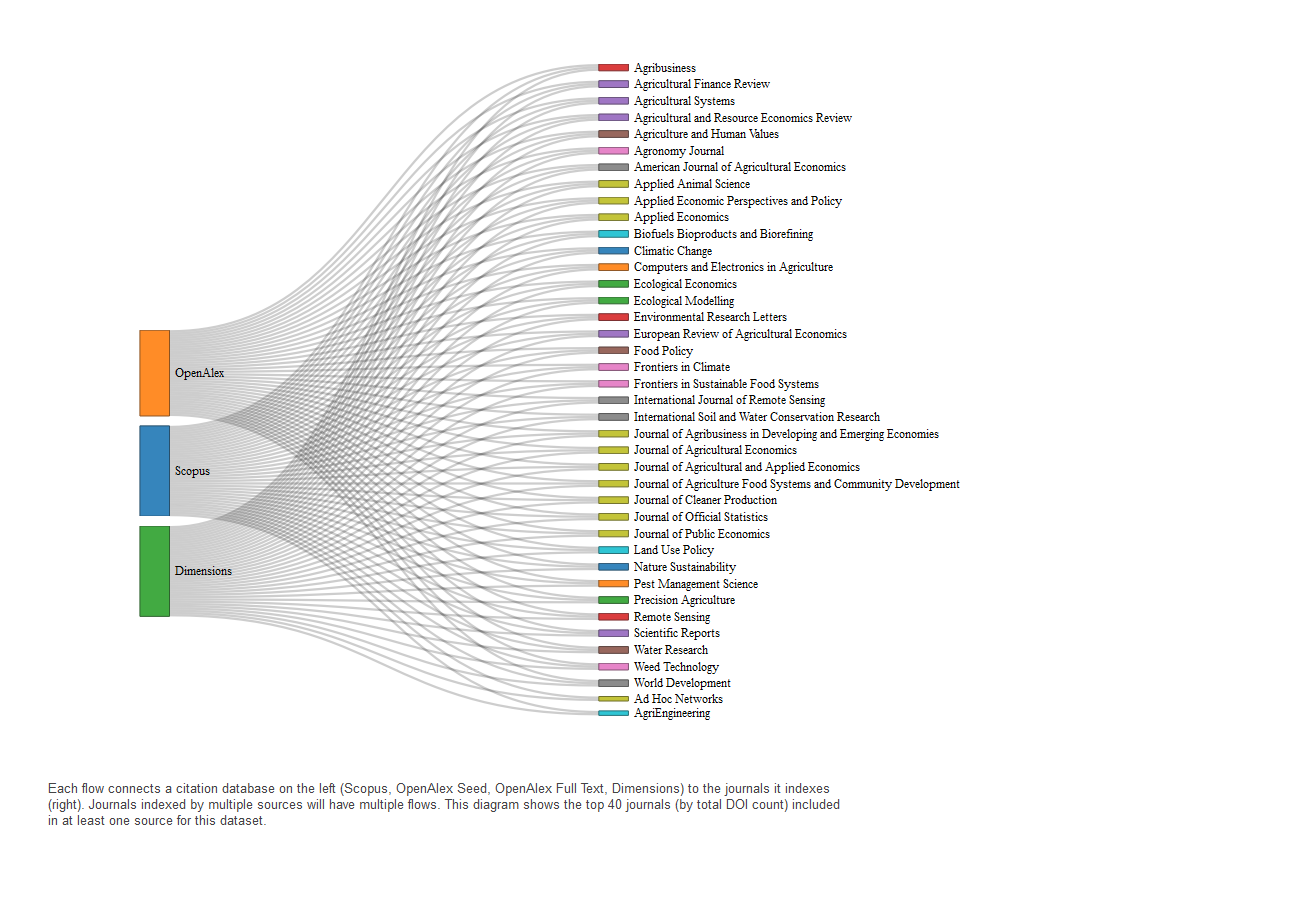
The Census of Agriculture
Journal coverage for Census-related publications is distributed more evenly across the three sources. Several journals—particularly in environmental and remote sensing fields—are indexed only in Scopus or Dimensions. Shared indexing is common for journals like Food Policy and Agricultural Systems, helping to explain the high level of overlap between Scopus and Dimensions.
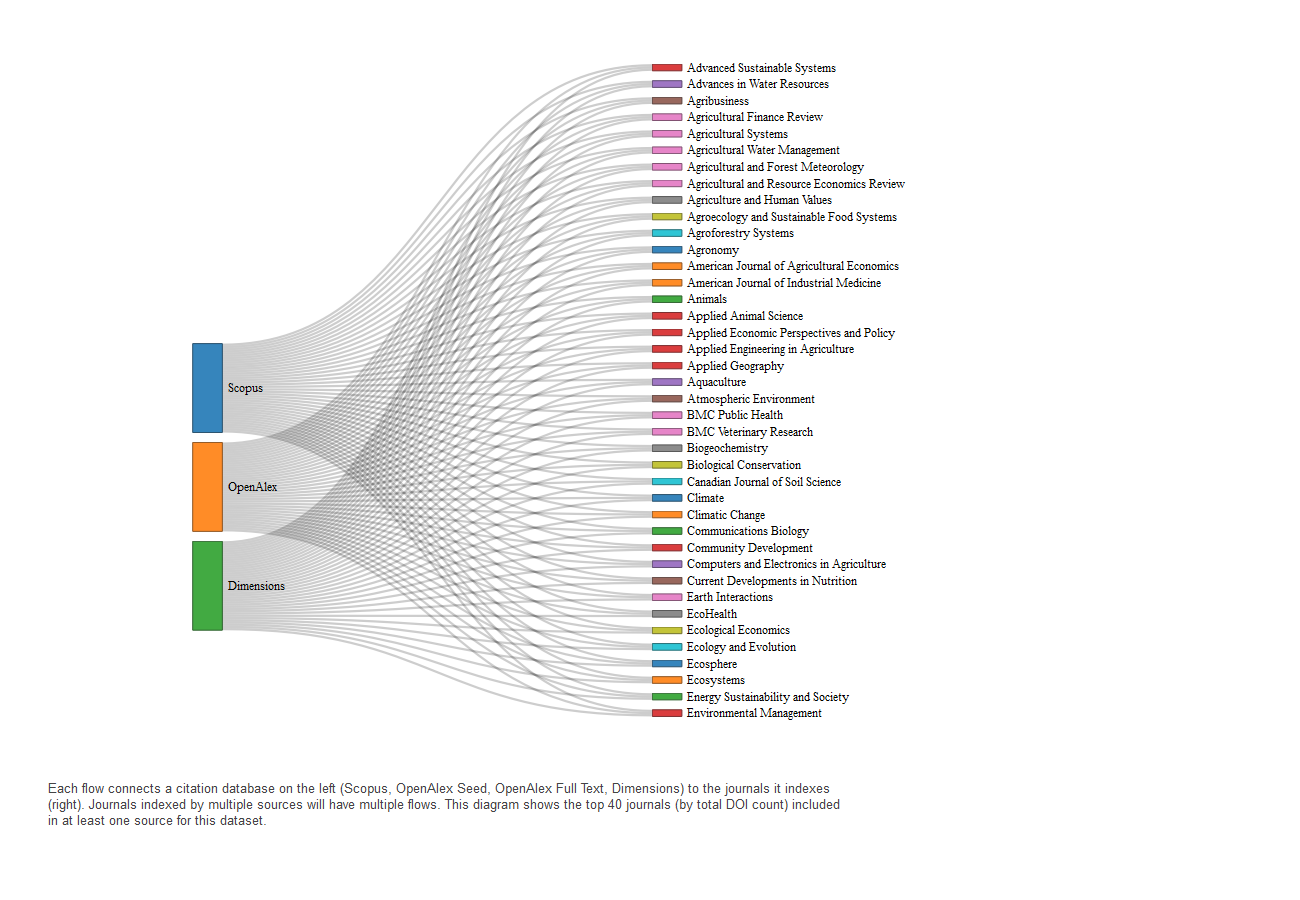
Food Access Research Atlas
This dataset is associated with journals that are broadly indexed across sources. Titles such as the Journal of Agricultural and Applied Economics and Ecological Economics are covered in all three databases. The strong overlap in journal indexing corresponds with the relatively balanced publication coverage observed in the prior section.

The Food Acquisition and Purchase Survey (FoodAPS)
Many FoodAPS-related journals fall within the nutrition and behavioral sciences domains, and several of these—such as Appetite and Frontiers in Nutrition—are indexed in OpenAlex. While a subset of journals is also covered by Scopus and Dimensions, OpenAlex appears to index more of the high-volume titles, consistent with its higher share of FoodAPS-related DOIs.
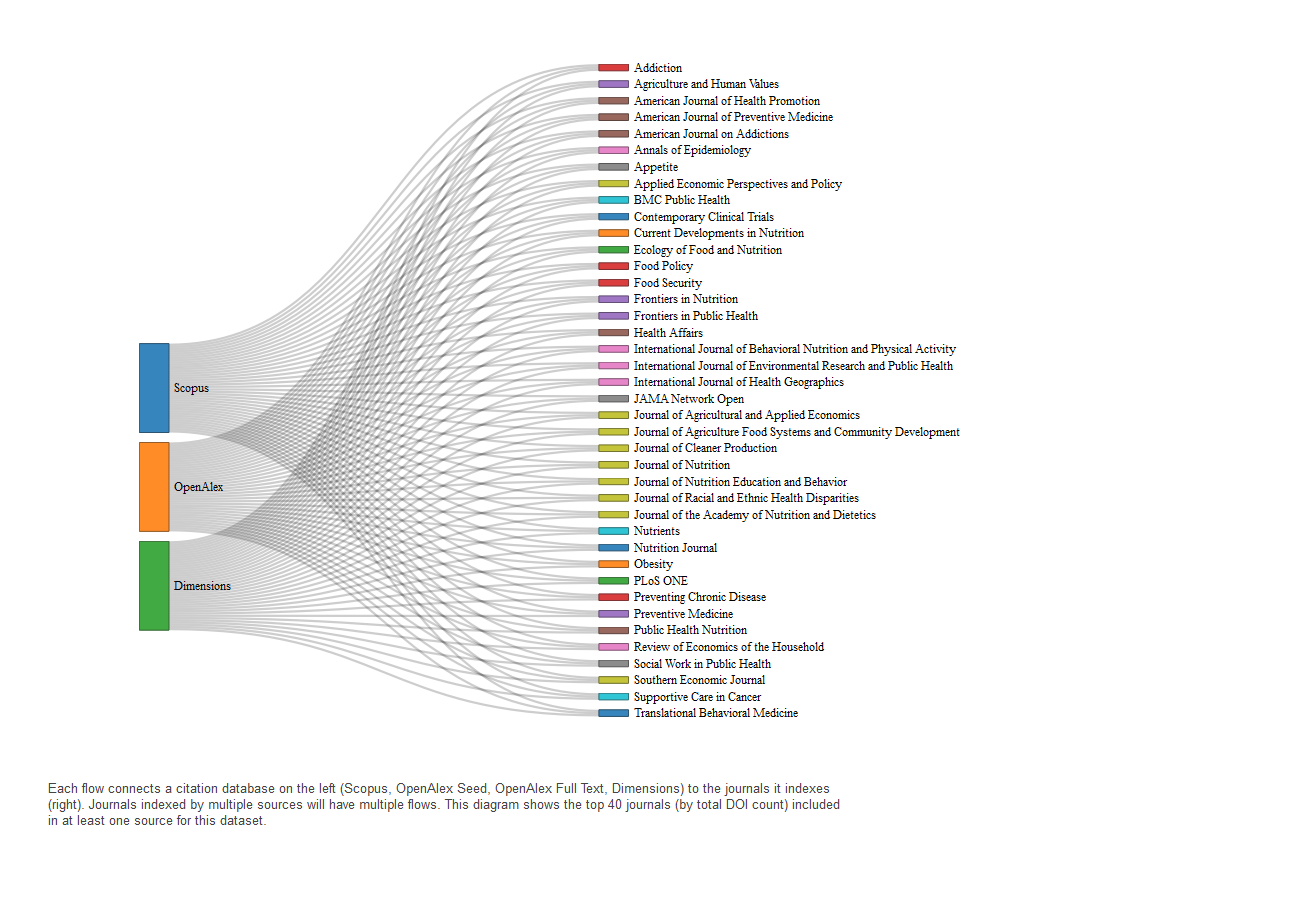
The Household Food Security Survey Module
This dataset draws from a wide range of journals in public health, food policy, and applied economics. Journals such as Food Security and Journal of Nutrition Education and Behavior appear in all three sources, but some health-focused titles are only indexed in Scopus or Dimensions. These differences likely contribute to the stronger coverage seen in Scopus and Dimensions.
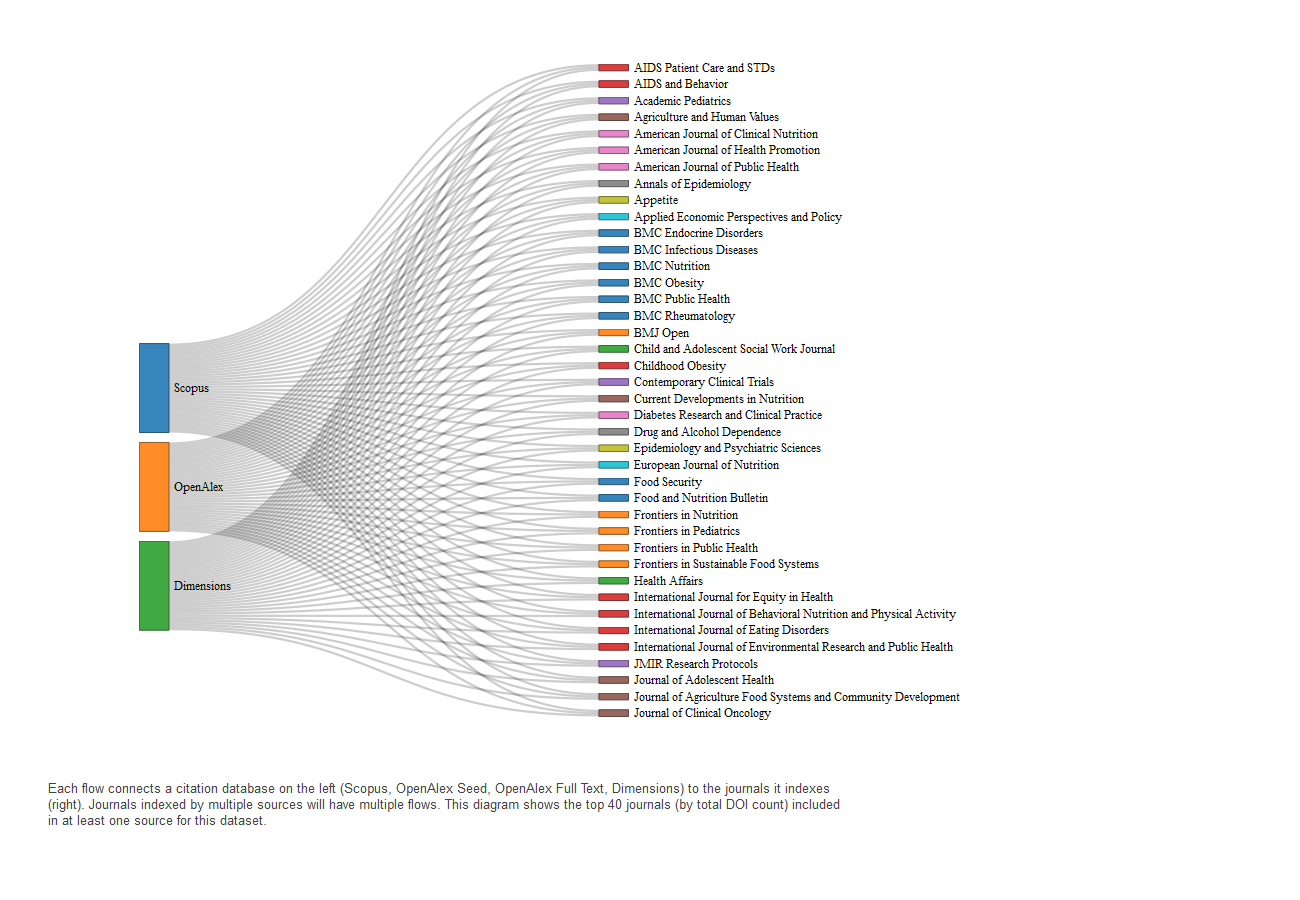
Rural-Urban Continuum Code
Journals citing RUCC span health, epidemiology, and rural development. Many are indexed in Scopus and Dimensions, including Environmental Research, BMC Public Health, and Drug and Alcohol Dependence. OpenAlex has more limited coverage of these titles, consistent with its lower representation of RUCC-related DOIs.
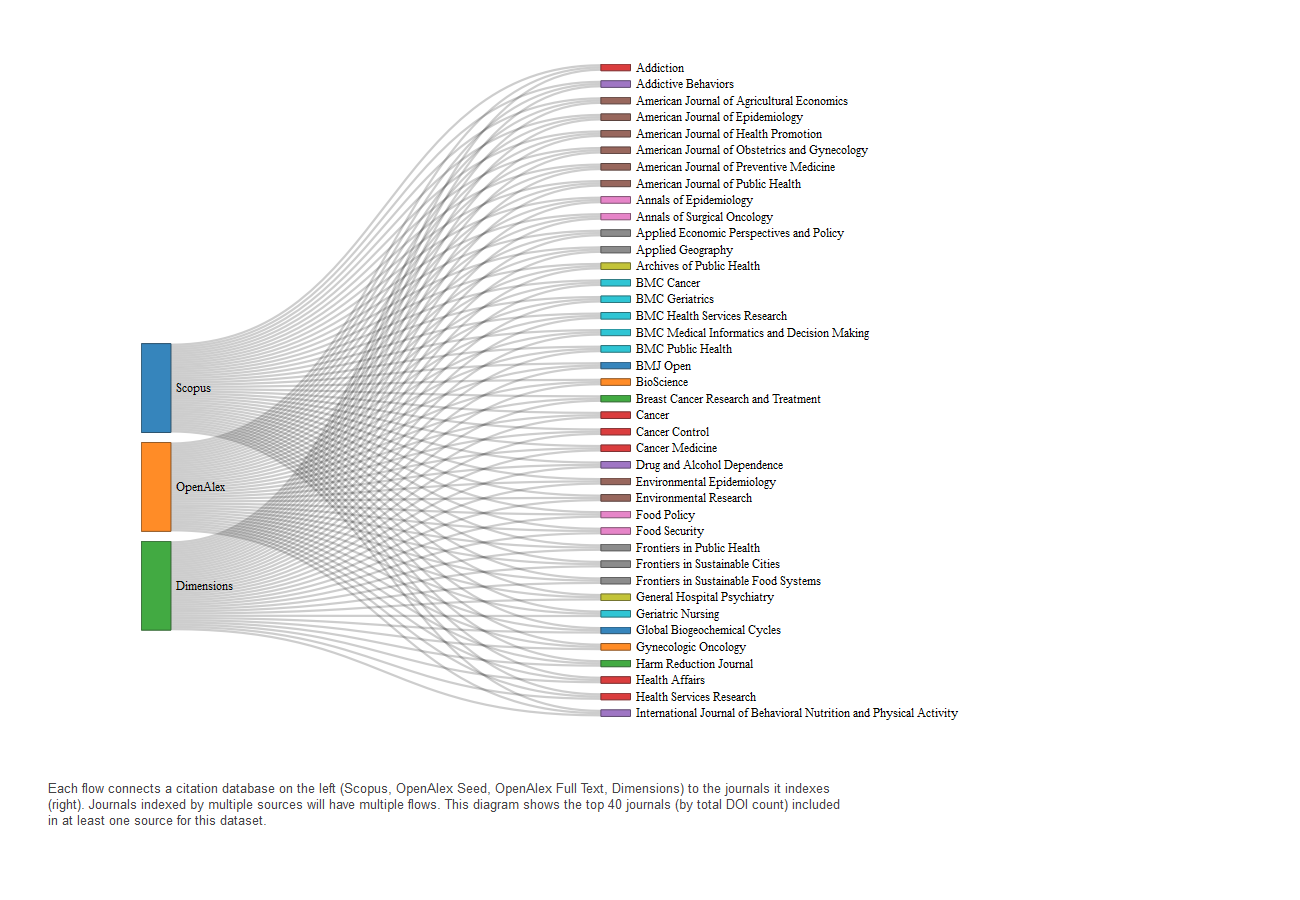
| Dataset | Dominant Source | Notable Journals Indexed in All Sources | Notable Journals Missing from Some Sources |
|---|---|---|---|
| ARMS | OpenAlex | AJAE, AEPP, Agribusiness | Few missing; OpenAlex covers most top journals |
| Census of Agriculture | Scopus / Dimensions | Food Policy, Agricultural Systems | Environmental/remote sensing journals missing in OpenAlex |
| Food Access Research Atlas | Shared | JAAEA, Ecological Economics | Broad overlap; minimal gaps |
| FoodAPS | OpenAlex | Food Security, Frontiers in Nutrition | Some nutrition journals missing in Scopus/Dimensions |
| HFSSM | Scopus / Dimensions | JNED, Food Security | Some public health journals missing in OpenAlex |
| RUCC | Scopus / Dimensions | Environmental Research, Food Policy | Several epidemiology/health titles missing in OpenAlex |
Explaining Differences in Database Coverage
We observed that OpenAlex indexes more publications referencing ARMS and FoodAPS than either Scopus or Dimensions. One possible reason for this difference is that OpenAlex may include a broader range of journals, including some that are less frequently indexed by other databases. However, we were unable to directly compare journal selectivity using standardized metrics like CiteScore, which are only available for journals indexed in Scopus.
To provide supporting evidence, we conducted two analyses using available article- and journal-level information:
The first analysis examines the extent to which journals are uniquely indexed by each bibliographic database. The orange bar chart below reports the share of journals that appear only in OpenAlex, only in Scopus, or only in Dimensions, based on journals that include at least one article referencing ARMS or FoodAPS. This provides a measure of database exclusivity at the journal level.
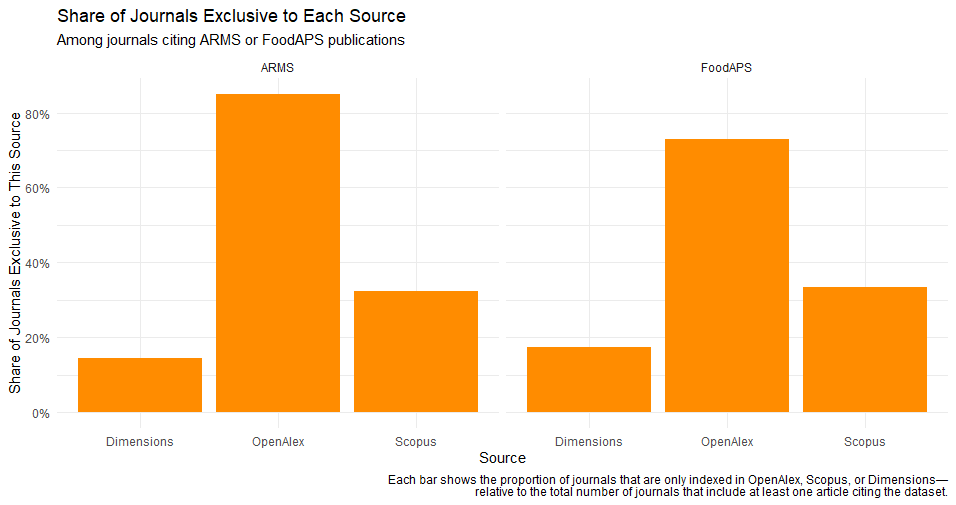
The second analysis focuses on article-level citations. The green bar chart below reports the median citation count of publications, grouped by the combination of sources in which each article appears (e.g., only in OpenAlex, in both OpenAlex and Dimensions, etc.). Citation counts were averaged across values reported in OpenAlex, Scopus, and Dimensions when available. Results are shown separately for ARMS and FoodAPS.
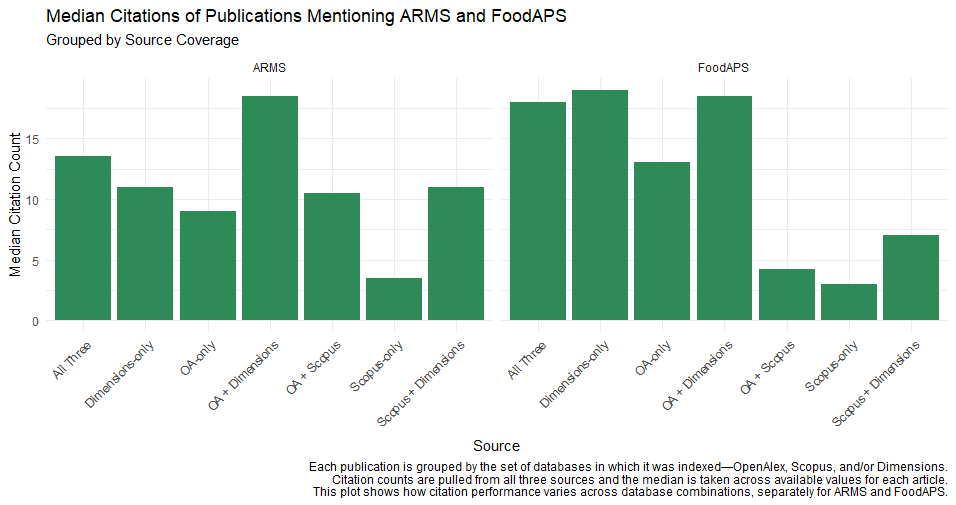
Taken together, these two pieces of evidence suggest that OpenAlex’s broader coverage may reflect its inclusion of a wider set of journals, including a longer tail of lower-cited publications, that may not appear in databases like Dimensions and Scopus, and that articles found only in OpenAlex tend to have lower citation counts than those indexed in Dimensions or shared across sources.
2.3.3 Publication Topics
In addition to differences in coverage and journal indexing, citation databases vary in how they classify research content. Each system applies a distinct taxonomy—often algorithmically generated—to assign topics to publications. These systems function like thematic filters, shaping how research is organized, discovered, and interpreted.
To understand how topic classification differs across sources, this section compares the most frequent topics assigned to the same set of publications by Scopus, OpenAlex, and Dimensions.
Why Focus on Overlapping Publications?
To ensure comparability, the analysis is restricted to DOIs that appear in all three databases. This approach isolates differences in classification by holding the underlying publication set constant. Any observed variation reflects how each database labels and groups the same publications.
Word Cloud Construction
For each dataset, the word clouds are based on frequency tables constructed from topic metadata assigned by each source. Specifically:
- The analysis filters to DOIs indexed by all three sources
- For each source, the corresponding topic classification schema is used to generate a count of how many DOIs are linked to each topic
- The word clouds visualize the top 100 most frequent topics assigned by each source to those shared DOIs
Source-specific classification methods include:
- Scopus: Author keywords and ASJC codes
- OpenAlex: Topic field from OpenAlex’s hierarchical ontology
- Dimensions: Concepts assigned using machine learning (per Dimensions API codebook)
A separate frequency table was generated for each source and dataset combination. These topic counts form the basis of the word clouds shown below.
Agricultural Resource Management Survey (ARMS)
These word clouds illustrate the most frequent research topics associated with shared DOIs (N = 30) across Scopus, OpenAlex, and Dimensions for the Agricultural Resource Management Survey (ARMS). While all three sources reflect a core emphasis on agricultural production and economics, the specific framing and vocabulary vary by platform:
Dimensions highlights terms grounded in applied research and policy-oriented topics such as marketing channels, soil health, farm succession, and cash transfers.
OpenAlex emphasizes conceptual and policy themes like agricultural innovations and practices, organic food and agriculture, and economic and environmental valuation.
Scopus features broader disciplinary categories and methodological terms including economics and econometrics, biofuel, development food science, and soil science.
The variation in topical emphasis reflects platform-specific differences in indexing practices, subject classification systems, and coverage of applied versus theoretical scholarship.
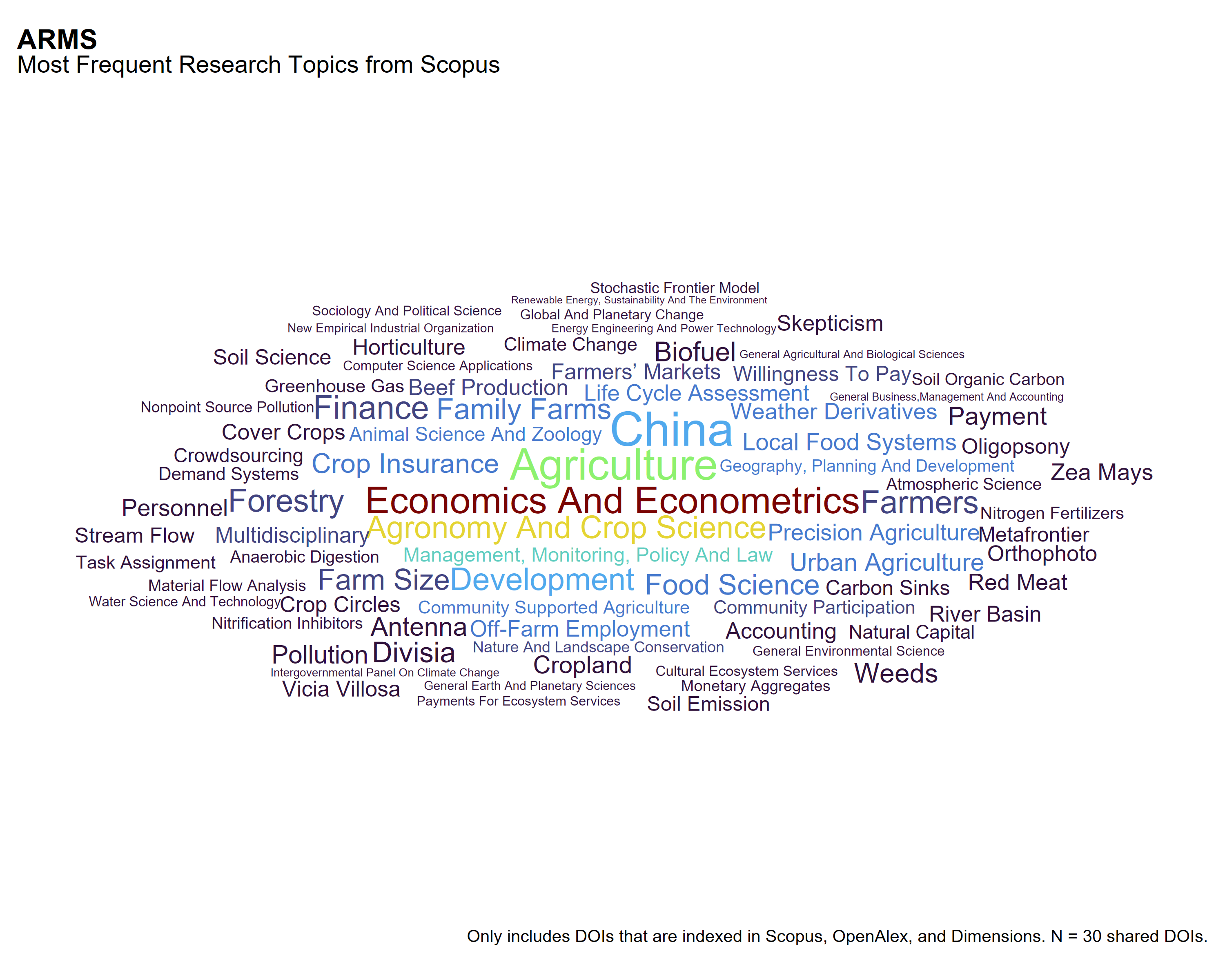
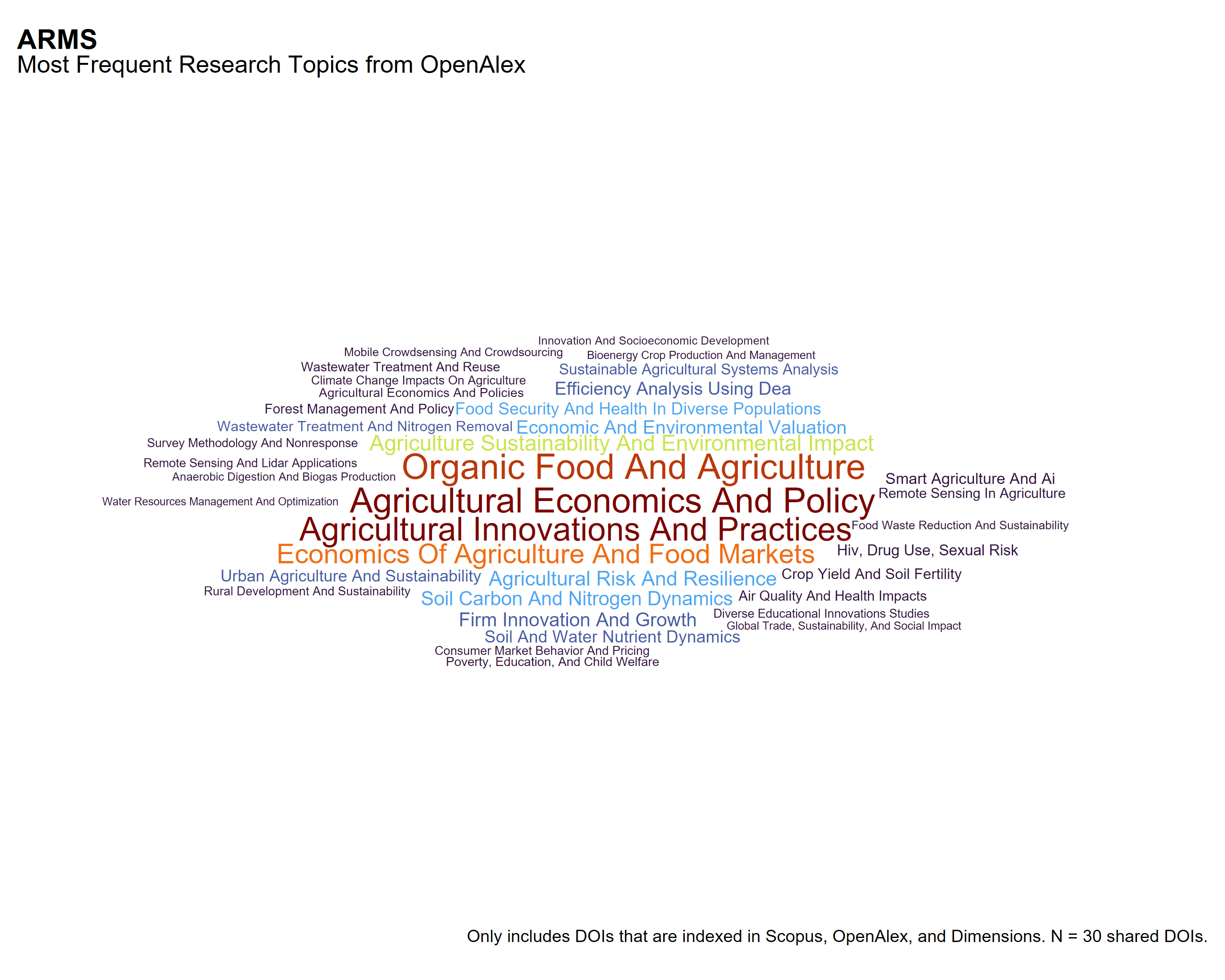

The next set of word clouds summarizes the most frequent research topics associated with publications that reference a given dataset, based on each source’s topic classification schema. The first word cloud in each section aggregates topics across all sources—Scopus, OpenAlex, and Dimensions—to provide a composite view of the research landscape. Readers can then click on source-specific word clouds, which reflect the full corpus of DOIs referencing the dataset within each source. These differences highlight how each platform categorizes scholarly content and may inform decisions about dataset visibility and disciplinary reach.
The Census of Agriculture
The word clouds below visualize the most frequent topics assigned to the 210 publications referencing the Census of Agriculture that are indexed in Scopus, OpenAlex, and Dimensions. The first image aggregates topic terms across all three sources. The remaining word clouds show how each individual source categorizes the same set of publications.
Each classification system presents a different view of the research landscape:
Dimensions emphasizes applied agricultural practice and land management topics, such as Cover Crops, Food Systems, Land Use, and No-Till. Many of the terms reflect production methods, conservation, and on-farm activities.
OpenAlex includes a wider range of thematic areas, with terms related to sustainability, valuation, and interdisciplinary research. Examples include Urban Agriculture and Sustainability, Economic and Environmental Valuation, and Food Waste Reduction.
Scopus reflects more traditional disciplinary structures, with emphasis on Ecology, Food Science, Economics and Econometrics, and Soil Emission. The presence of terms like China and Urban Agriculture points to geographic and policy framing as well.
These differences reflect variation in how each source structures and assigns topical metadata to the same publications.
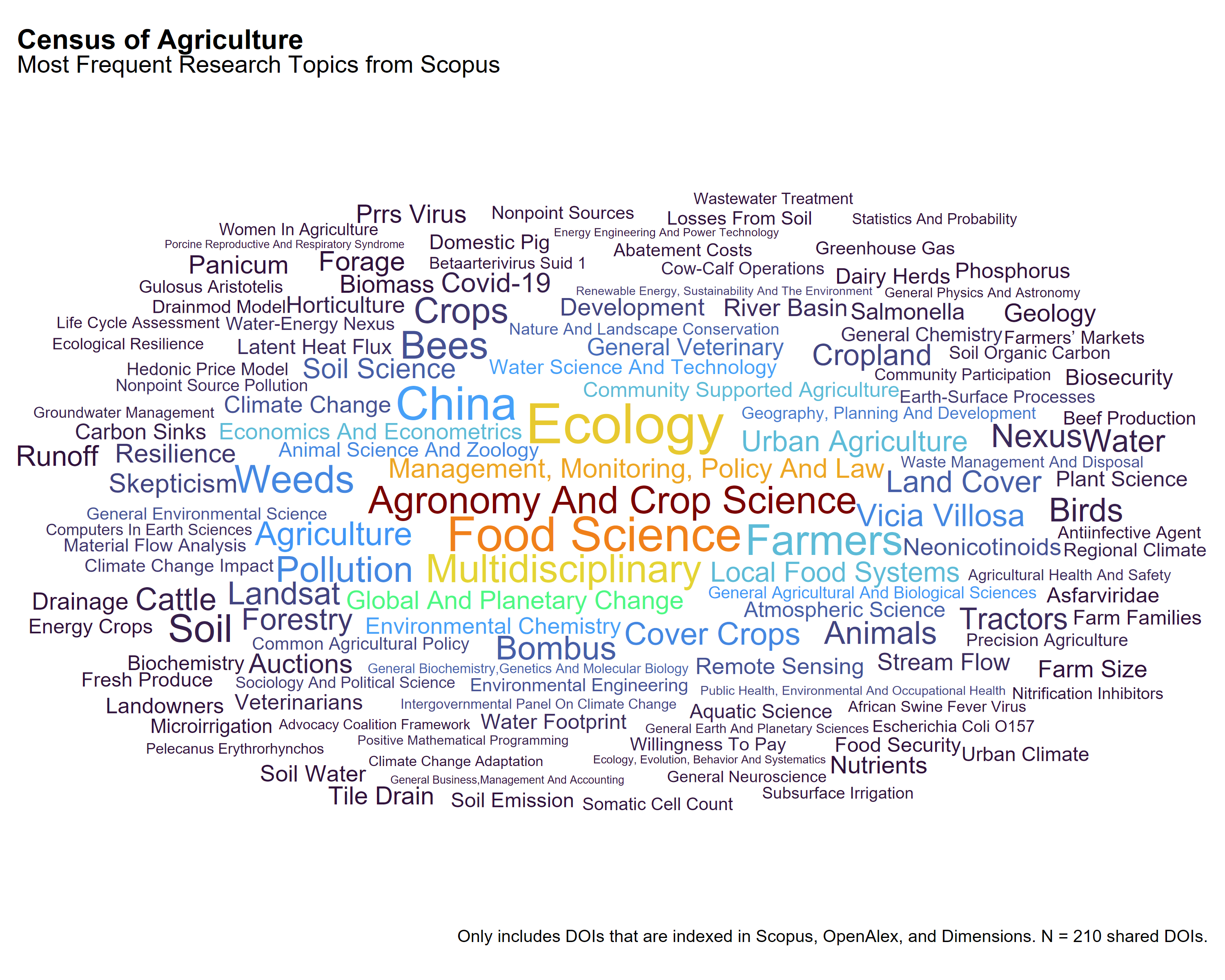
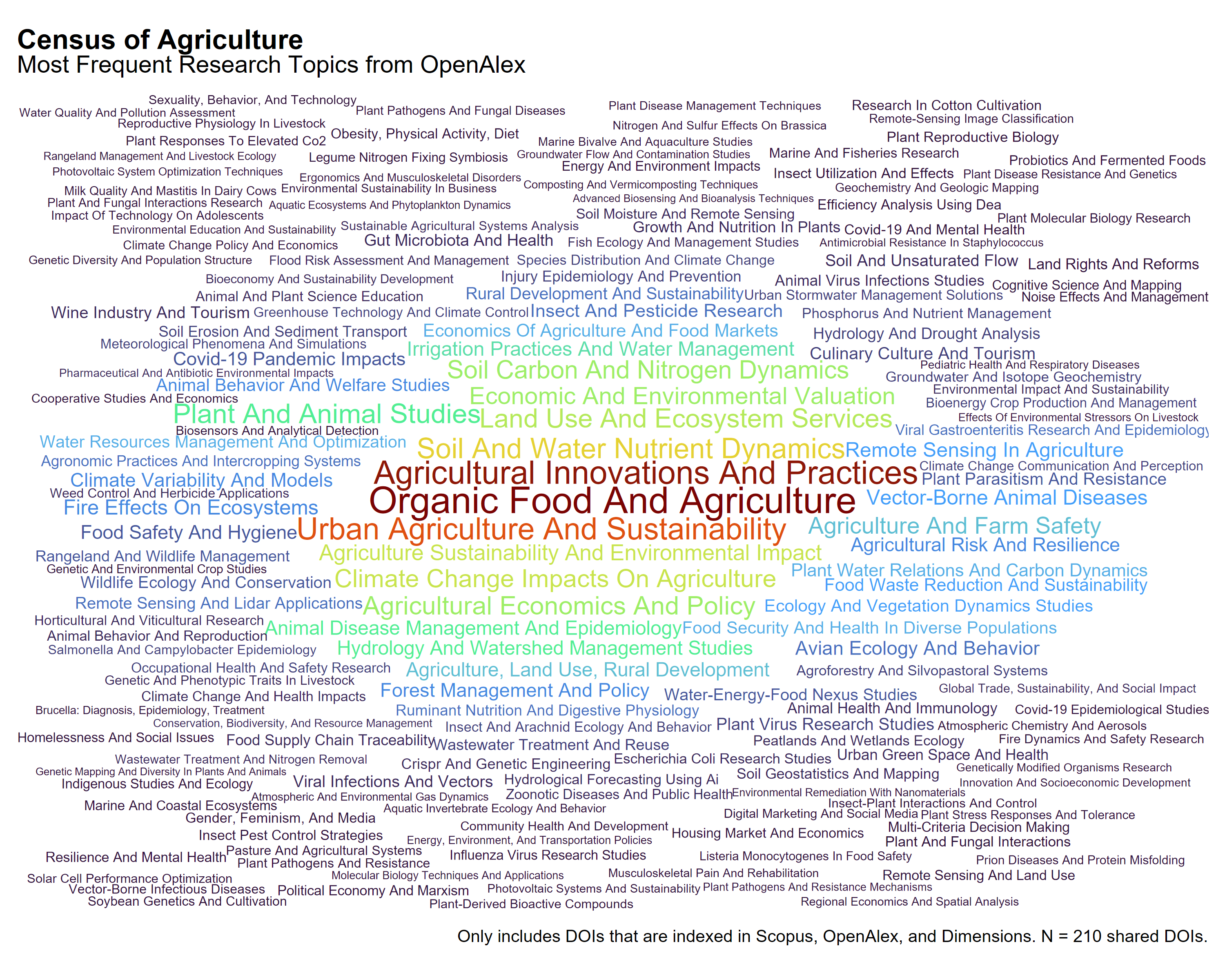
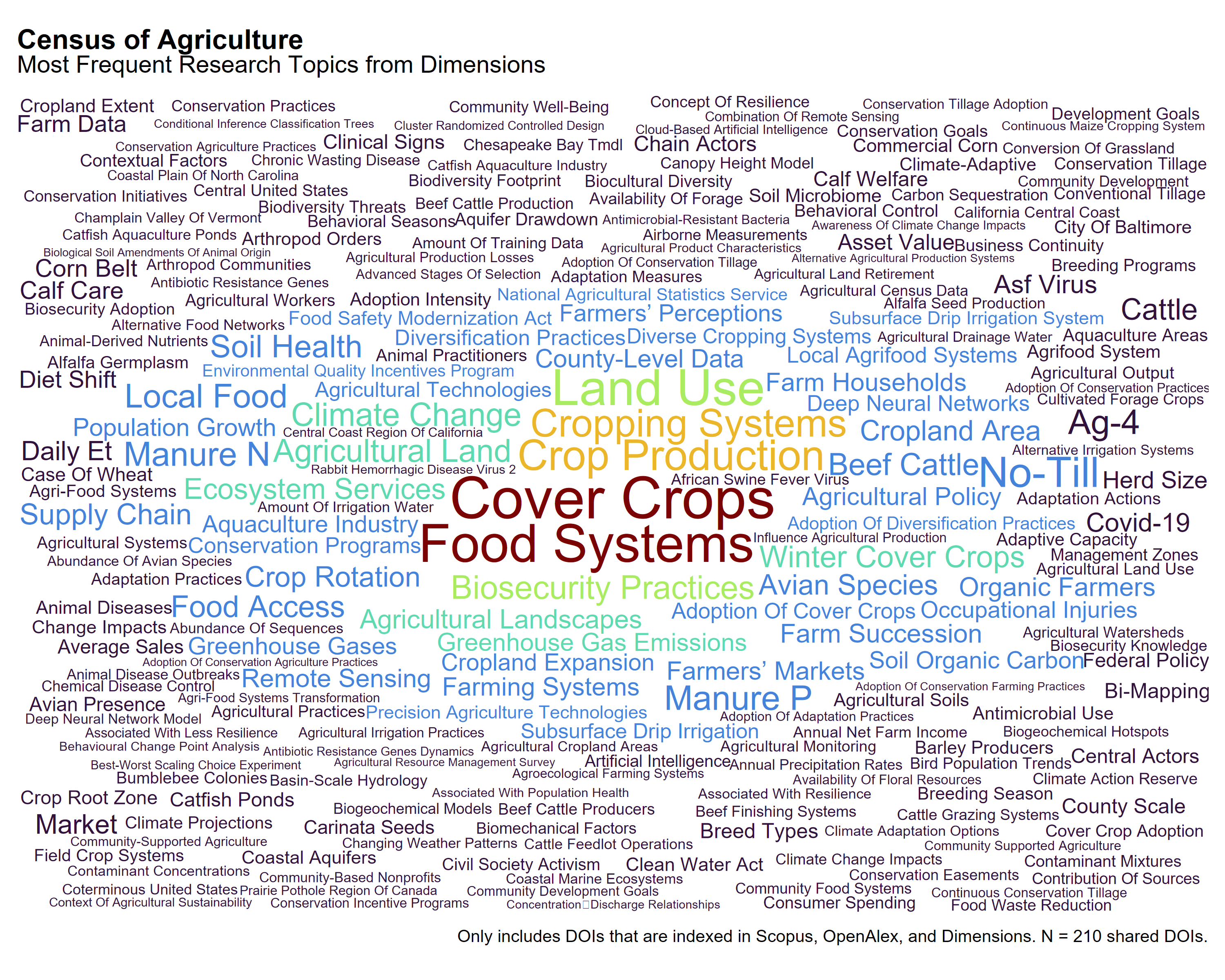
The next set of word clouds summarizes the most frequent research topics associated with publications that reference a given dataset, based on each source’s topic classification schema. The first word cloud in each section aggregates topics across all sources—Scopus, OpenAlex, and Dimensions—to provide a composite view of the research landscape. Readers can then click on source-specific word clouds, which reflect the full corpus of DOIs referencing the dataset within each source. These differences highlight how each platform categorizes scholarly content and may inform decisions about dataset visibility and disciplinary reach.
Food Access Research Atlas
For the 65 publications indexed across Scopus, OpenAlex, and Dimensions that reference the Food Access Research Atlas, topic classifications vary by source. Each database reflects different emphases in how it organizes subject matter related to food environments and neighborhood-level access.
Dimensions highlights terms associated with food insecurity and nutrition assistance, including Food Deserts, Food Insecurity, SNAP Participants, and Census Tracts. The topics are often grounded in program participation, geographic mapping, and diet-related outcomes, suggesting an applied framing centered on public policy and access programs.
OpenAlex points to broader social and environmental determinants of health, with topics like Obesity, Physical Activity, Diet, Food Security and Health in Diverse Populations, and Urban Agriculture and Sustainability. Its classifications suggest greater integration of population health, urban studies, and structural considerations.
Scopus displays a mix of disciplinary and clinical topics, including Obesity, Grocery Stores, Farmers’ Markets, and Public Health. Additional terms such as Anthropology, Exercise, Surgery, and Biomedical Engineering reflect coverage from journals in the health sciences, indicating a more biomedical orientation.
Together, these differences suggest that Dimensions frames FARA-related research through the lens of policy and programmatic access, OpenAlex places greater emphasis on social context and urban health, and Scopus reflects disciplinary classifications from medicine, biology, and public health. These variations may influence how different audiences encounter and interpret research using this dataset.
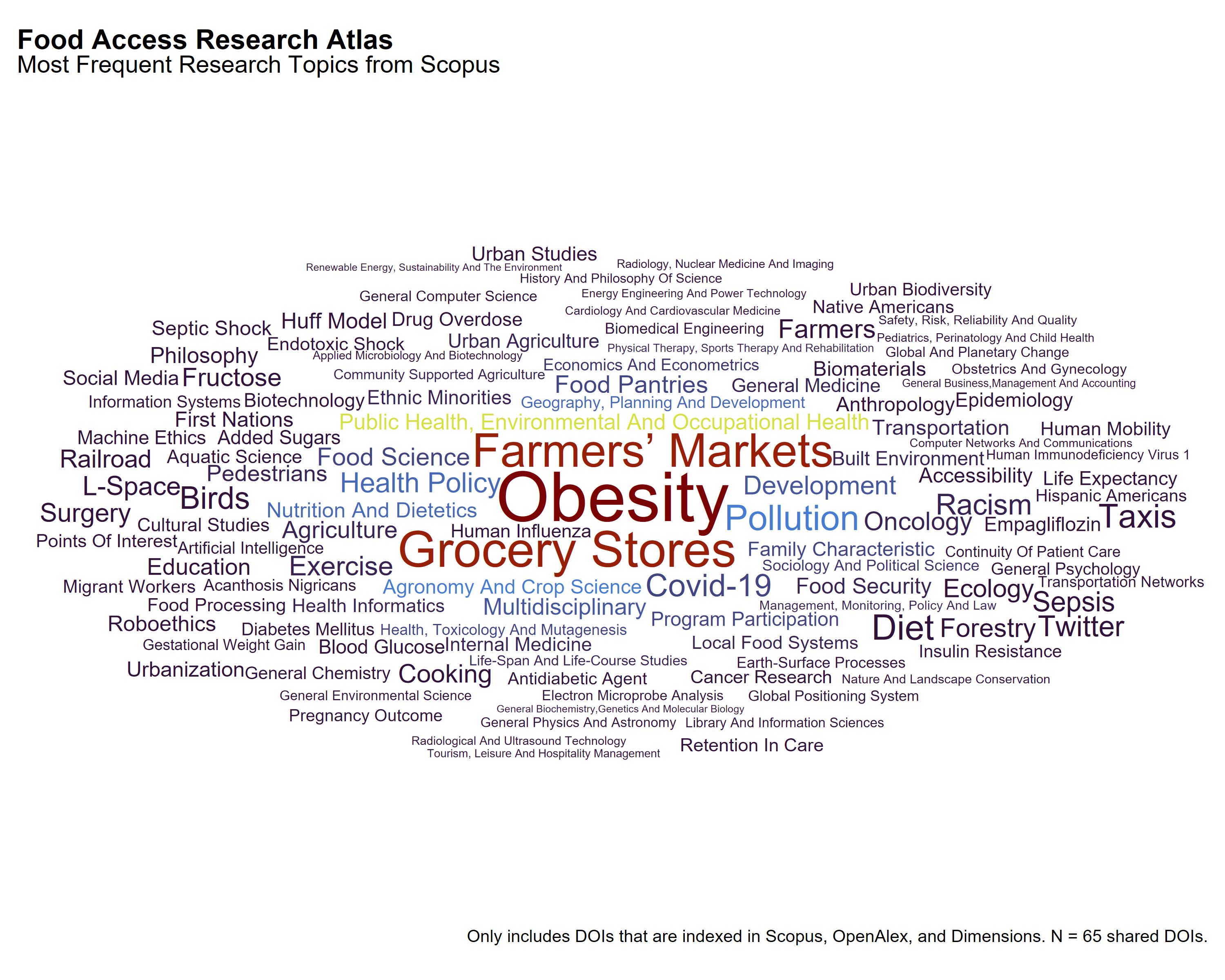
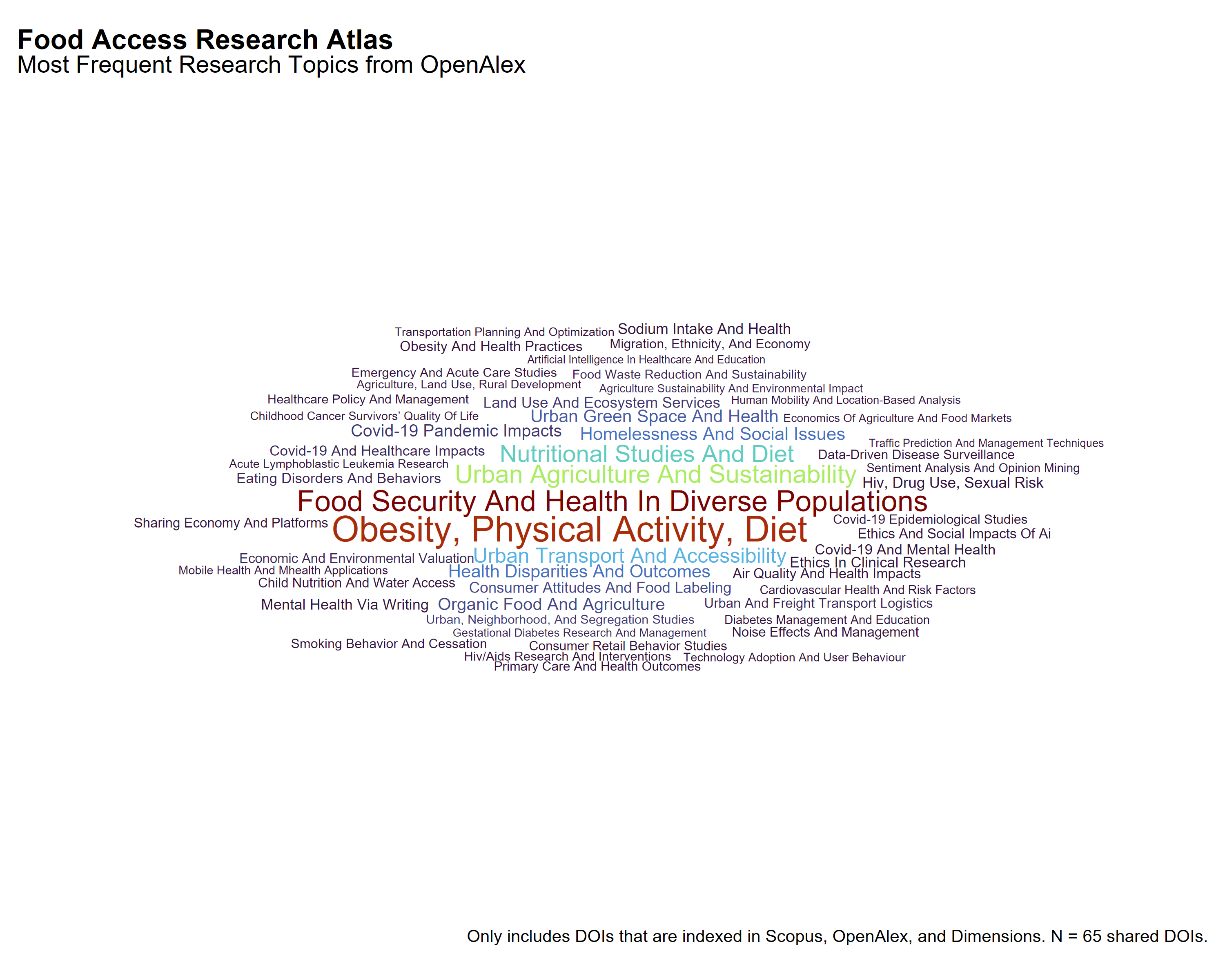
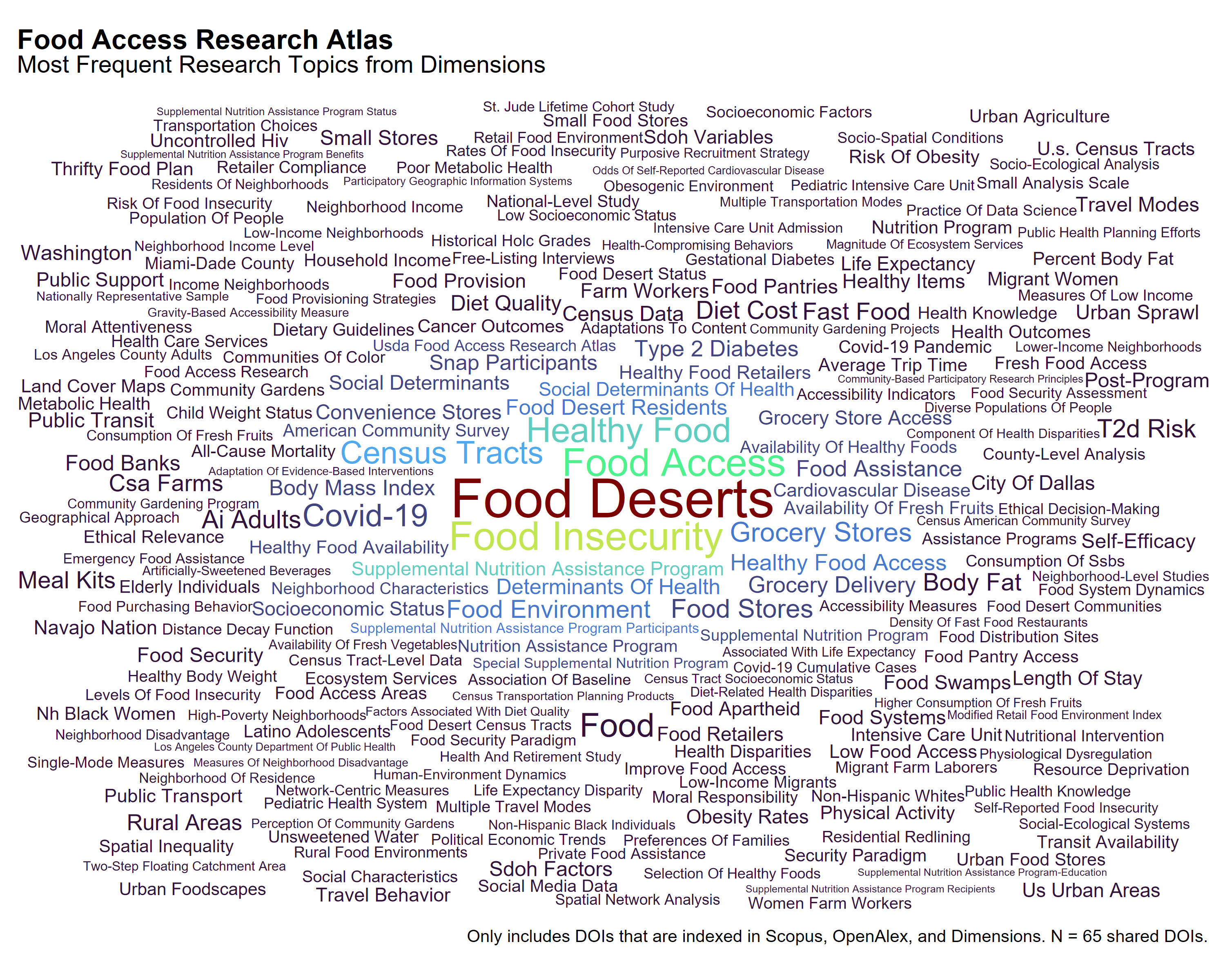
The next set of word clouds summarizes the most frequent research topics associated with publications that reference a given dataset, based on each source’s topic classification schema. The first word cloud in each section aggregates topics across all sources—Scopus, OpenAlex, and Dimensions—to provide a composite view of the research landscape. Readers can then click on source-specific word clouds, which reflect the full corpus of DOIs referencing the dataset within each source. These differences highlight how each platform categorizes scholarly content and may inform decisions about dataset visibility and disciplinary reach.
The Food Acquisition and Purchase Survey (FoodAPS)
Among the 38 DOIs referencing FoodAPS that appear in all three citation databases, each source assigns different topic labels, offering varied perspectives on the dataset’s use in scholarly research.
Dimensions emphasizes topics directly connected to food purchasing and economic access. Prominent terms include Diet Cost, Food Environment, Thrifty Food Plan, and Supplemental Nutrition Assistance Program. These labels reflect applied work related to food affordability, policy programs, and nutrition behavior, often at the household level.
OpenAlex highlights broader public health themes such as Obesity, Physical Activity, Diet and Food Security and Health in Diverse Populations. It also includes terms related to structural and behavioral contexts—Urban Agriculture and Sustainability, Homelessness and Social Issues, and Consumer Attitudes and Food Labeling—suggesting a focus on population-level outcomes and intersectional influences on food access.
Scopus shows more disciplinary and intervention-related topics. Terms like Grocery Stores, Farmers’ Markets, Nutrition and Dietetics, and Obesity appear frequently, alongside topics such as Brand Placement, Food Labeling, and Program Participation, indicating interest in behavioral nutrition, food marketing, and policy evaluation.
These differences suggest that Dimensions favors classification by programmatic and economic relevance, OpenAlex aligns more with public health and social research, and Scopus tends to organize around disciplinary domains and evaluation studies.
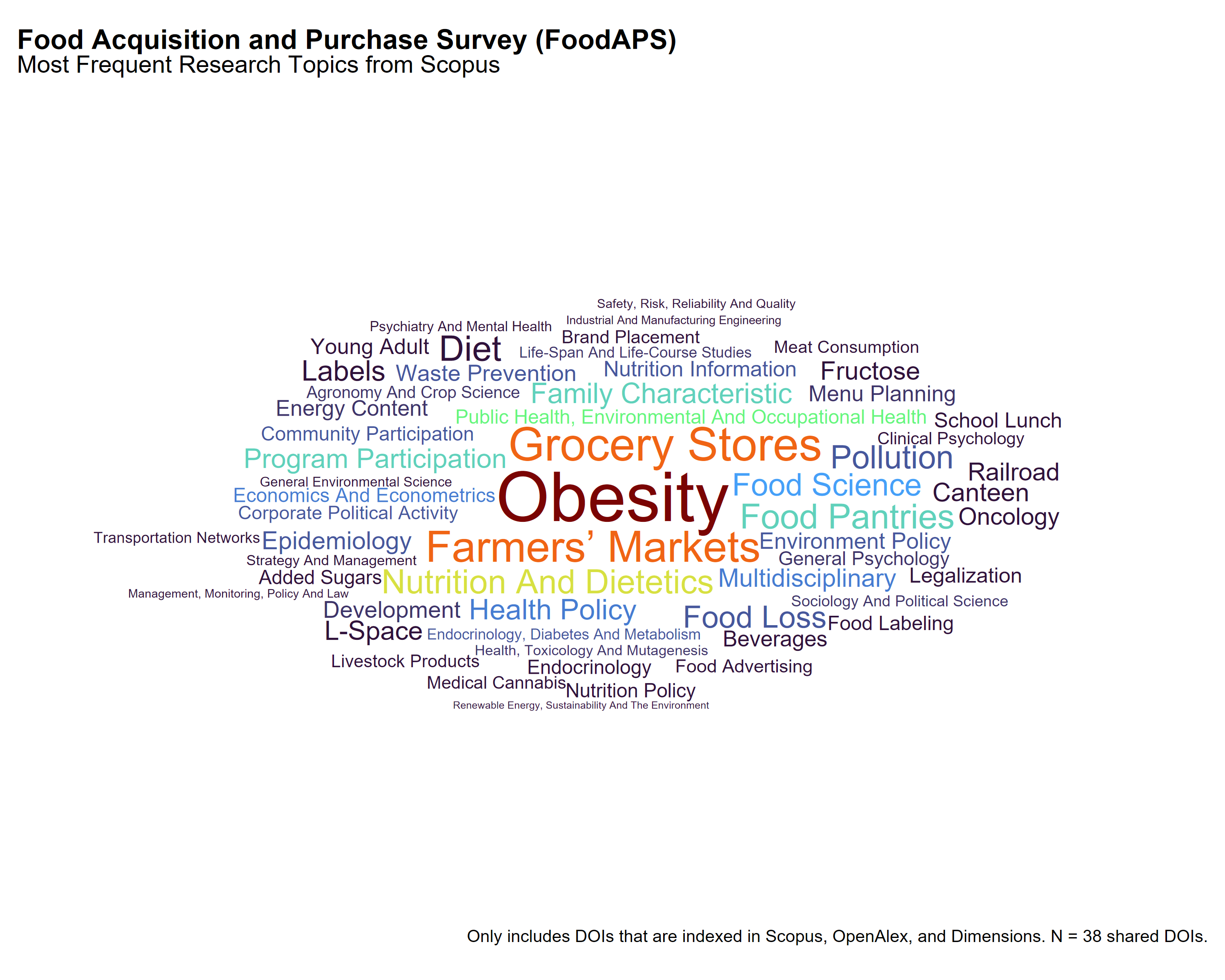
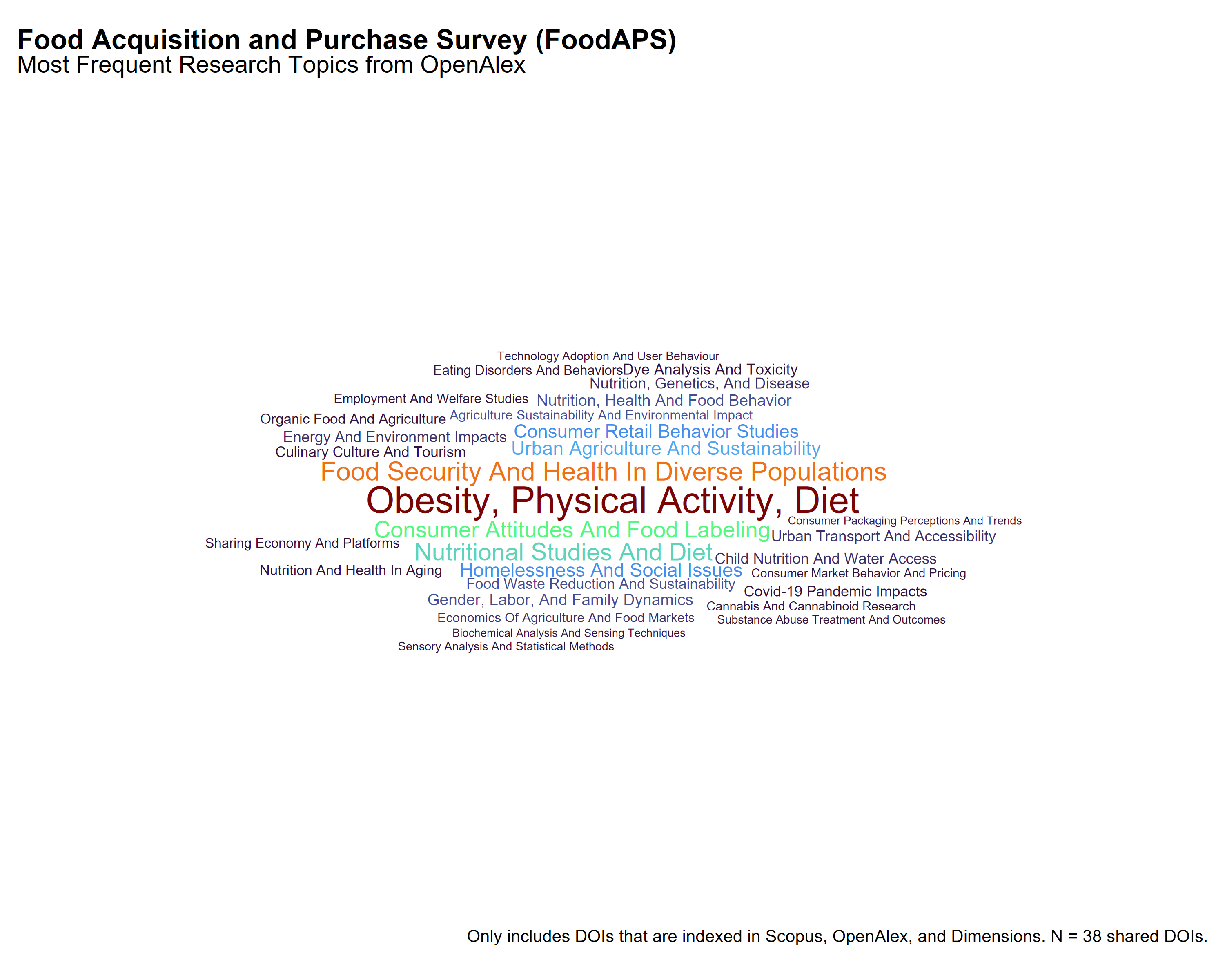
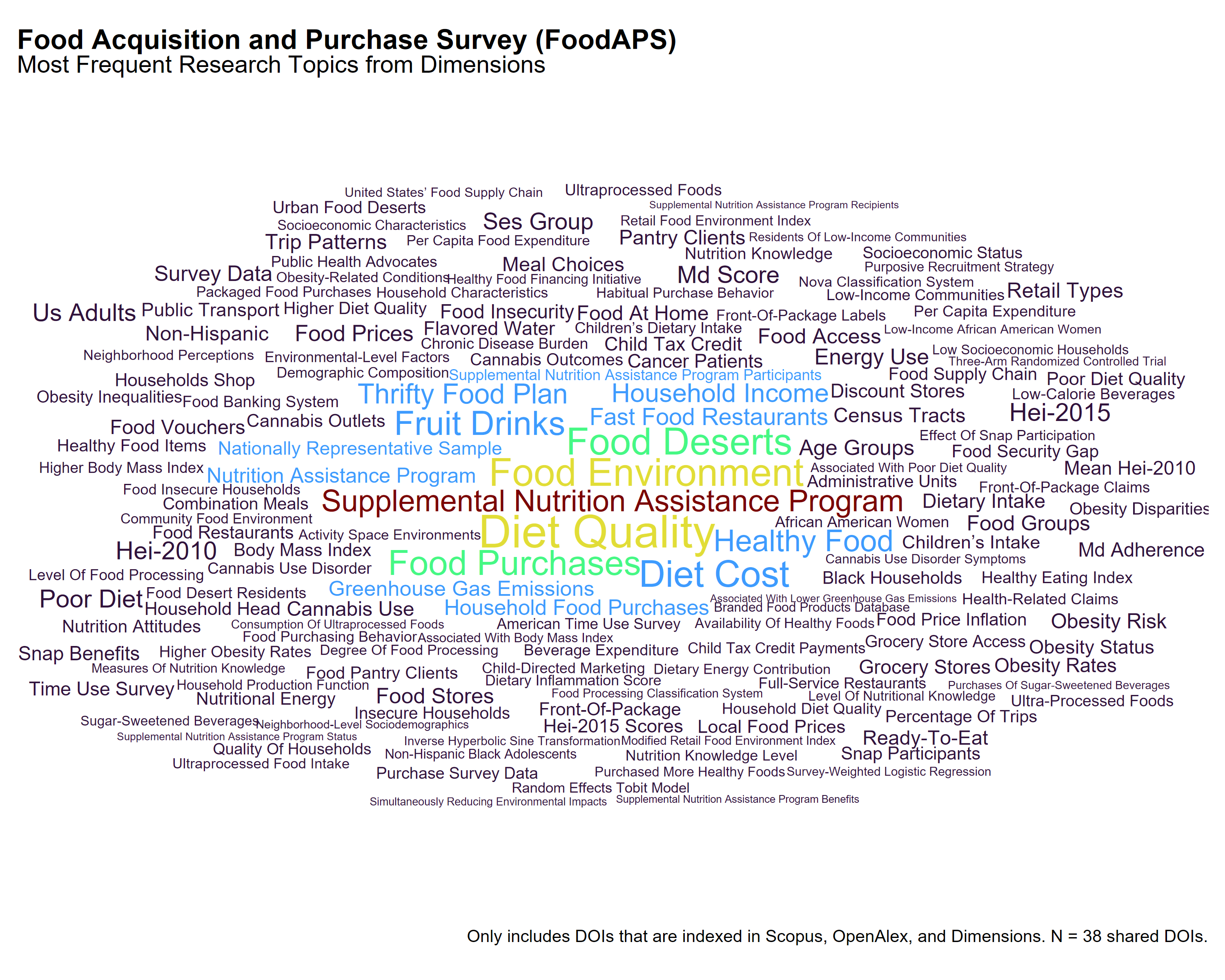
The next set of word clouds summarizes the most frequent research topics associated with publications that reference a given dataset, based on each source’s topic classification schema. The first word cloud in each section aggregates topics across all sources—Scopus, OpenAlex, and Dimensions—to provide a composite view of the research landscape. Readers can then click on source-specific word clouds, which reflect the full corpus of DOIs referencing the dataset within each source. These differences highlight how each platform categorizes scholarly content and may inform decisions about dataset visibility and disciplinary reach.
The Household Food Security Survey Module
Among the 82 DOIs referencing the Household Food Security Survey Module (HFSSM) that are indexed in Scopus, OpenAlex, and Dimensions, each citation database reflects a distinct emphasis in topical classification.
Dimensions highlights food insecurity, supplemental nutrition assistance, and diet quality as central themes, along with demographic and health-related topics such as older adults, physical activity, mental health, and household income. These reflect a strong policy and program-oriented lens, focused on vulnerable populations and health outcomes.
OpenAlex surfaces broader population health and structural themes. Top topics include Food Security and Health in Diverse Populations, Obesity, Physical Activity, Diet, and Homelessness and Social Issues. The emphasis here leans toward sociomedical framing and public health determinants, especially at the community or systems level.
Scopus features terms like Food Pantries, Program Participation, and Family Characteristic, consistent with food access research. But it also brings in more disciplinary and biomedical language—Epigenetics, Cancer, Autism, and Mindfulness—pointing to research that draws on HFSSM data to explore clinical and psychological outcomes.
Together, these patterns show how different databases frame the same set of publications through different classification systems. While the core themes of food security and health are shared, each source emphasizes different disciplinary, policy, or structural dimensions of the research.
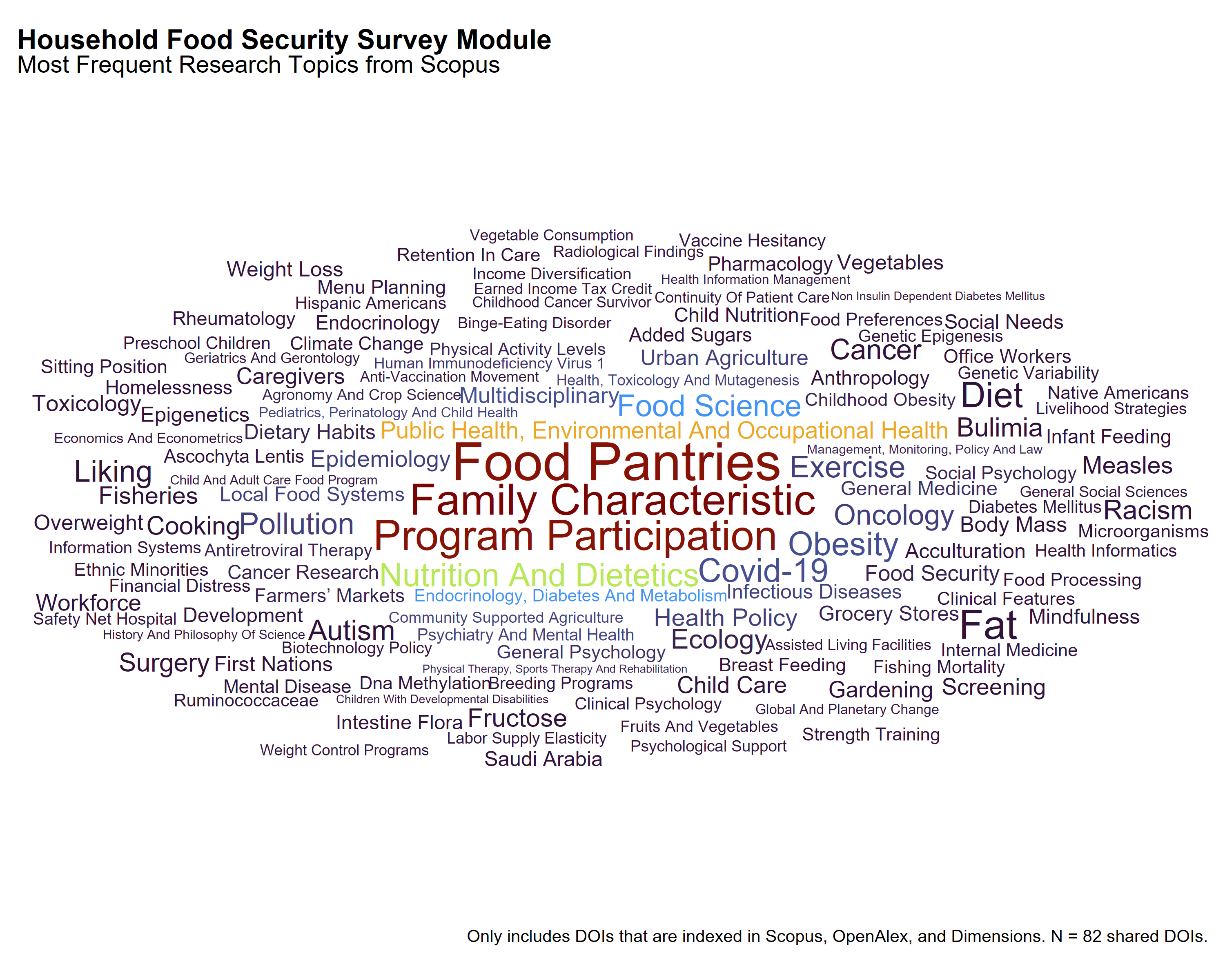
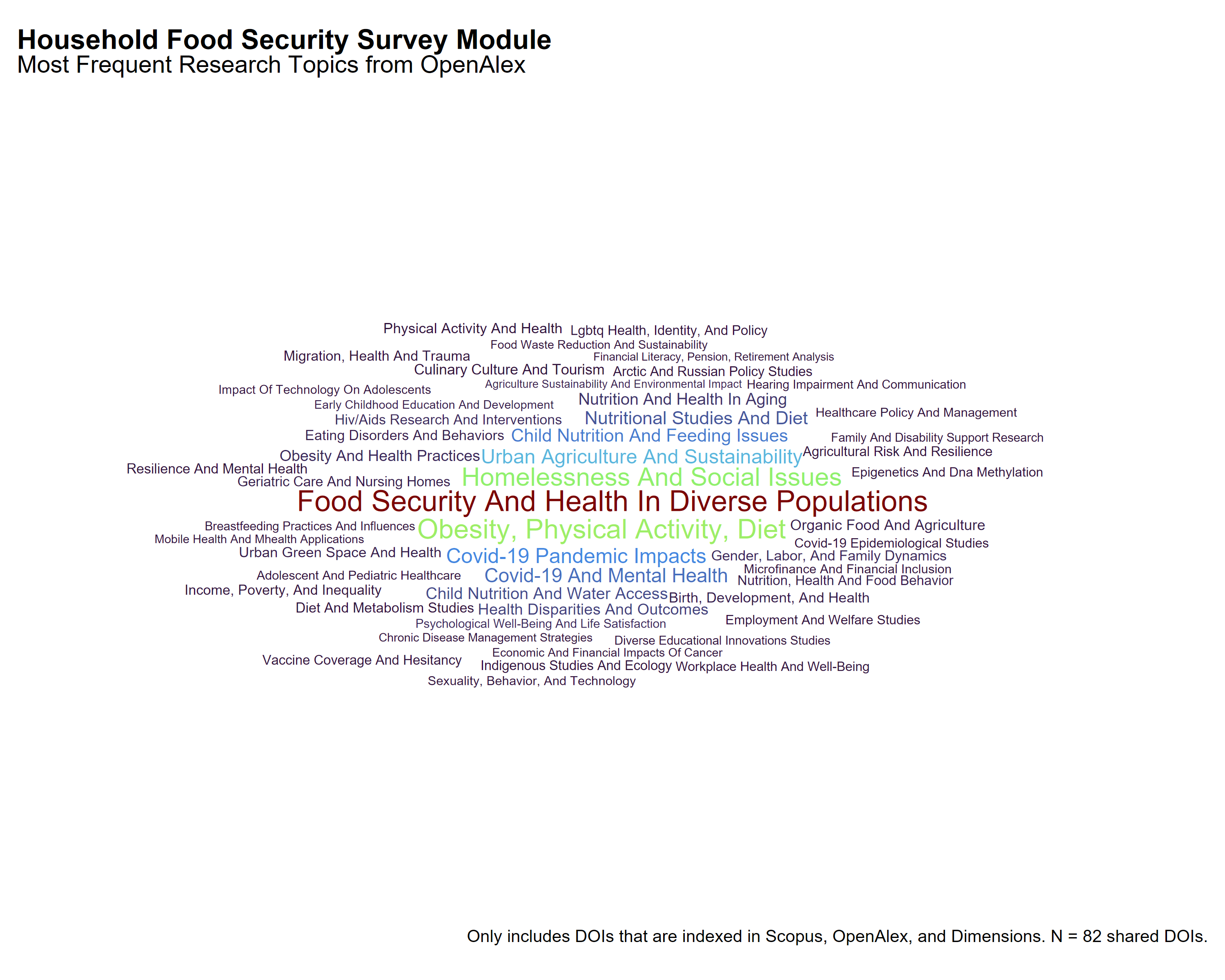
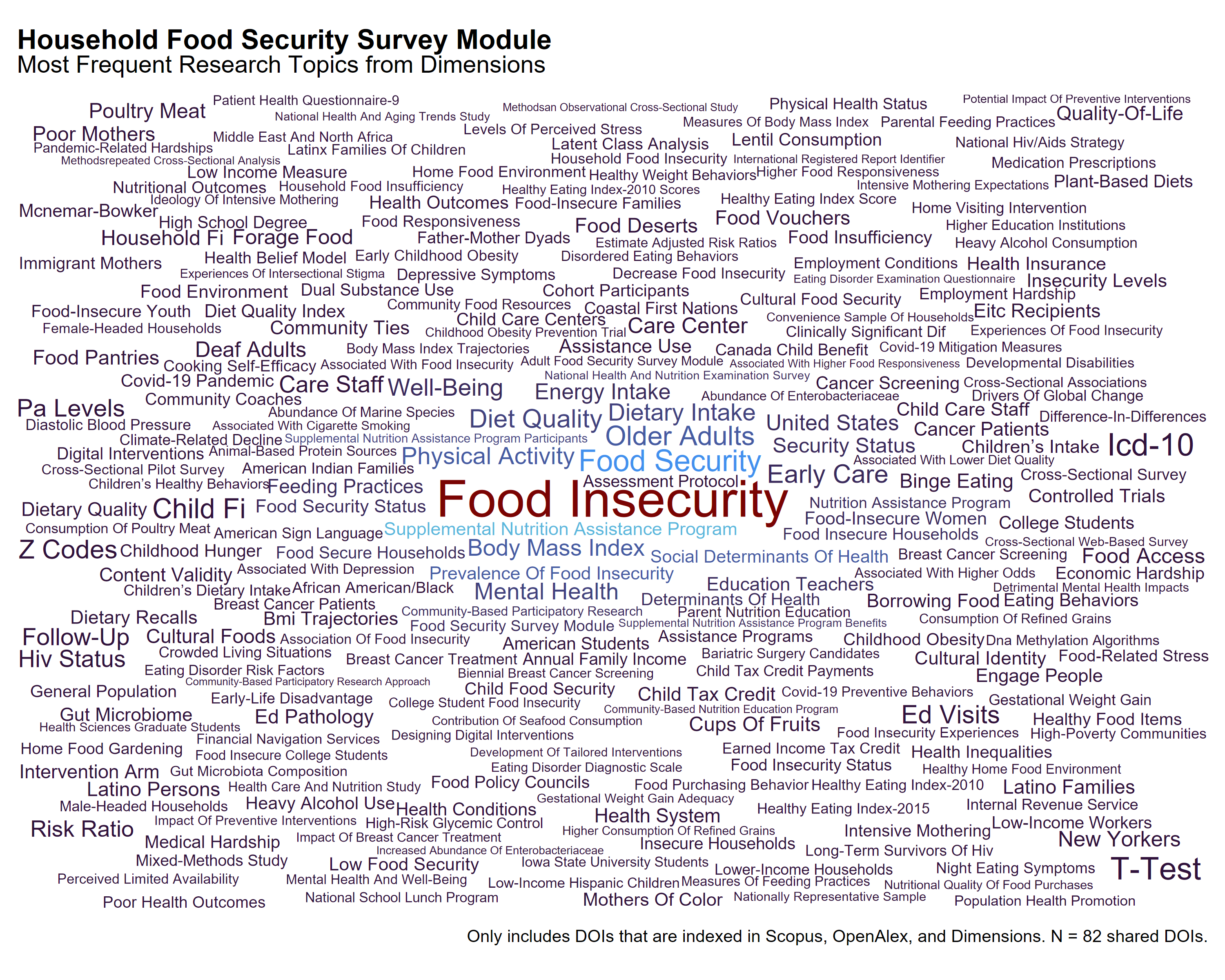
The next set of word clouds summarizes the most frequent research topics associated with publications that reference a given dataset, based on each source’s topic classification schema. The first word cloud in each section aggregates topics across all sources—Scopus, OpenAlex, and Dimensions—to provide a composite view of the research landscape. Readers can then click on source-specific word clouds, which reflect the full corpus of DOIs referencing the dataset within each source. These differences highlight how each platform categorizes scholarly content and may inform decisions about dataset visibility and disciplinary reach.
Rural-Urban Continuum Code
Among the 130 DOIs referencing the Rural-Urban Continuum Code (RUCC) dataset that appear in Scopus, OpenAlex, and Dimensions, topic classifications consistently focus on rural health disparities, healthcare access, and population-level outcomes, though each database frames these themes differently.
Dimensions places the strongest emphasis on county-level characteristics and rural infrastructure. Terms such as rural counties, older adults, cancer incidence, and opioid use disorder are prominent, reflecting the dataset’s utility for examining geographic variation in health outcomes and healthcare delivery.
OpenAlex centers its taxonomy on population health and structural factors. Topics like opioid use disorder treatment, health disparities and outcomes, and global cancer incidence and screening signal a focus on equity and large-scale health systems research. Behavioral health and environmental health are also prominent themes.
Scopus reflects a broader mix of clinical and disciplinary topics. Frequent terms include Covid-19, cancer, public health, obesity, and health policy. Additional tags such as smoking ban, rural poverty, and Medicaid point to both policy-oriented and biomedical lines of research.
Together, these differences illustrate how the same publications are categorized through different topical lenses, depending on the underlying classification systems used by each database.
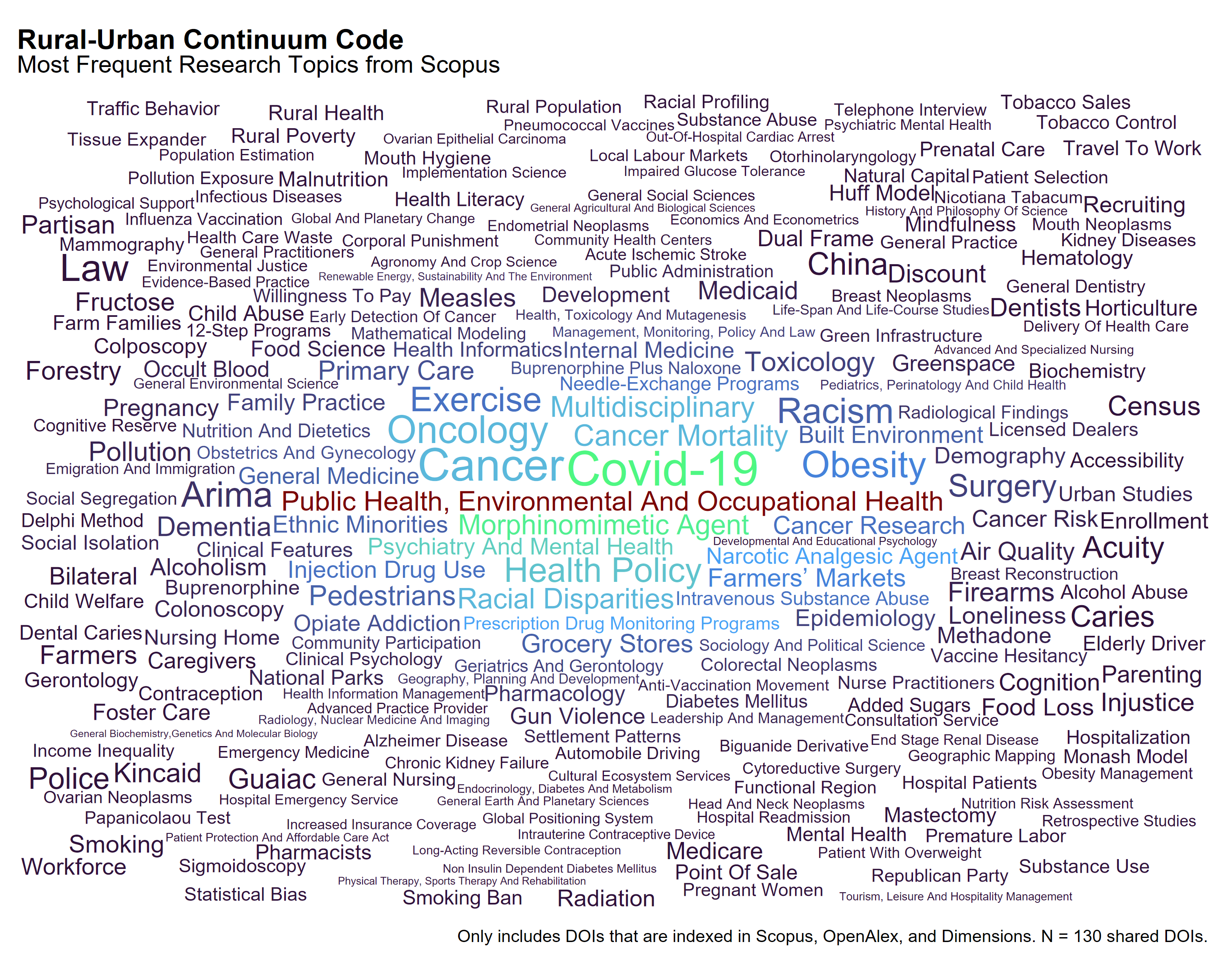
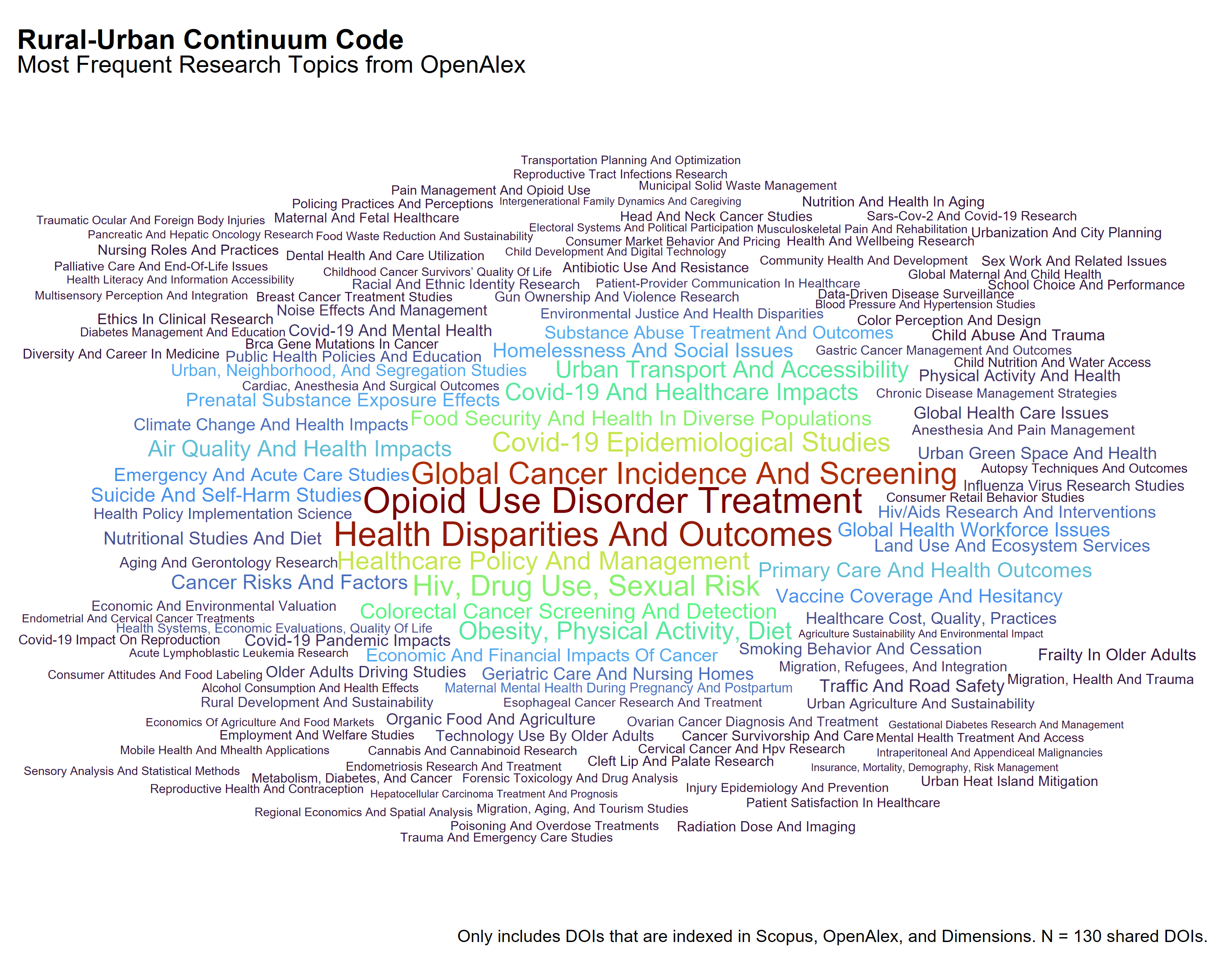
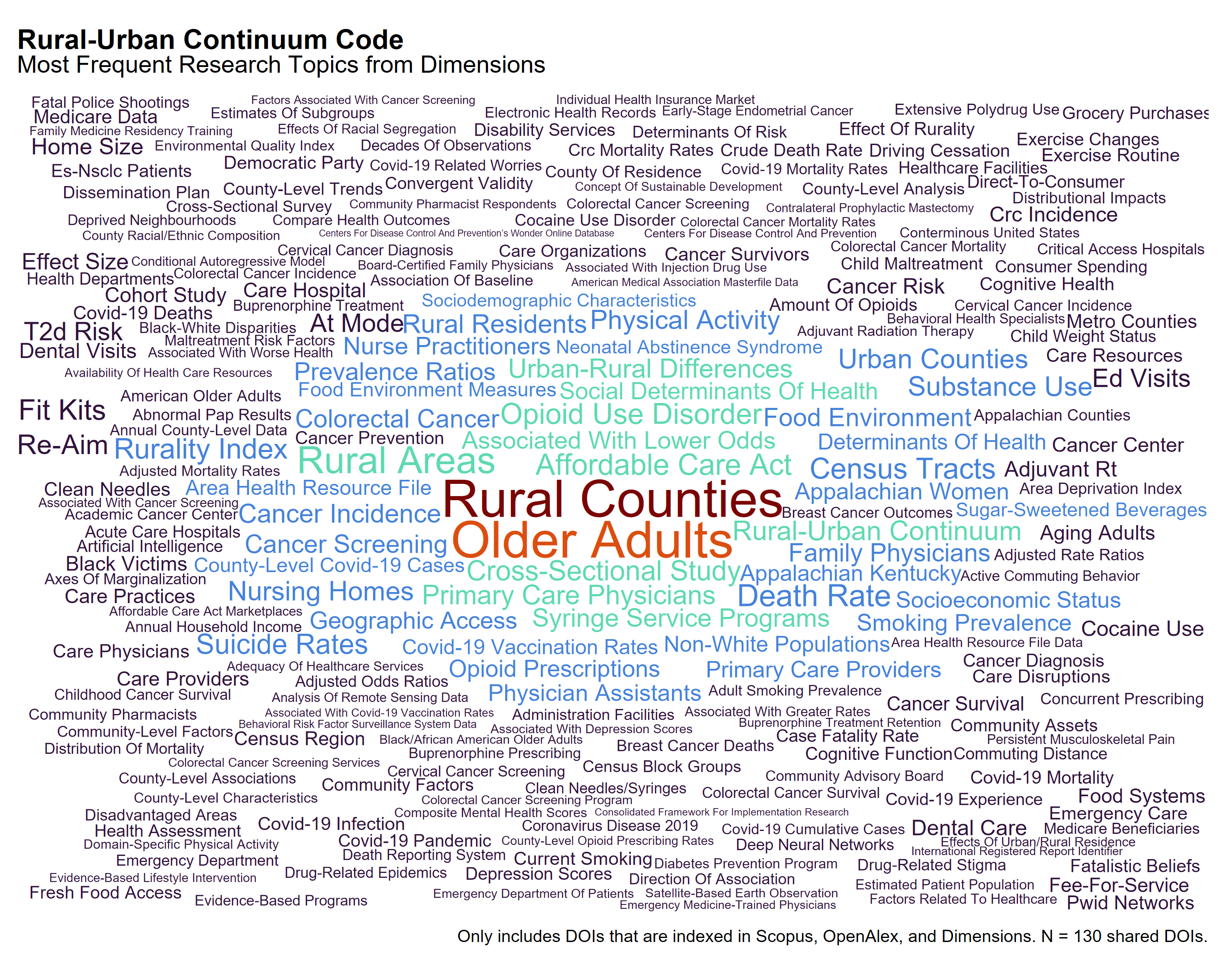
The next set of word clouds summarizes the most frequent research topics associated with publications that reference a given dataset, based on each source’s topic classification schema. The first word cloud in each section aggregates topics across all sources—Scopus, OpenAlex, and Dimensions—to provide a composite view of the research landscape. Readers can then click on source-specific word clouds, which reflect the full corpus of DOIs referencing the dataset within each source. These differences highlight how each platform categorizes scholarly content and may inform decisions about dataset visibility and disciplinary reach.
2.3.5 Institutional Comparison
In addition to examining dataset mention coverage, the report also evaluates differences in institutional representation across Scopus, OpenAlex, and Dimensions. Each of the featured citation databases represent some portion of the global research landscape, yet their inclusion criteria and institutional coverage may vary. The purpose of this analysis is to assess which institutions are represented in each source.
2.4 Conclusion
This report compares how publications referencing the Census of Agriculture are captured across Scopus, OpenAlex, and Dimensions. Each platform provides only partial coverage of relevant publications, with limited overlap between sources. Variation in indexing practices, topic classification systems, and metadata availability contributes to differences in which publications, research topics, and authors are included. These discrepancies have implications for measuring the reach and influence of federal datasets and underscore the importance of carefully evaluating citation sources when assessing research use.
The current study aimed to include institution-level analysis using integrated IPEDS and MSI data, but full implementation was beyond the scope of the current work. An appendix provides preliminary documentation and visualization of institutional coverage patterns using harmonized IPEDS and MSI datasets from 2017 to 2023. These materials outline the steps to continue the analysis of institutional representation, particularly for Minority-Serving Institutions, but were not included in the primary results.
Tables
| Topic ID | Topic Name | Full-Text Search Count | Total Count |
|---|---|---|---|
| T11610 | Impact of Food Insecurity on Health Outcomes | 549 | 78661 |
| T10010 | Global Trends in Obesity and Overweight Research | 272 | 111686 |
| T11066 | Comparative Analysis of Organic Agricultural Practices | 247 | 41275 |
| T12253 | Urban Agriculture and Community Development | 222 | 27383 |
| T10367 | Agricultural Innovation and Livelihood Diversification | 186 | 49818 |
| T11464 | Impact of Homelessness on Health and Well-being | 175 | 101019 |
| T12033 | European Agricultural Policy and Reform | 137 | 88980 |
| T10841 | Discrete Choice Models in Economics and Health Care | 126 | 66757 |
| T10596 | Maternal and Child Nutrition in Developing Countries | 116 | 118727 |
| T11898 | Impacts of Food Prices on Consumption and Poverty | 113 | 29110 |
| T11259 | Sustainable Diets and Environmental Impact | 109 | 45082 |
| T11311 | Soil and Water Nutrient Dynamics | 84 | 52847 |
| T10235 | Impact of Social Factors on Health Outcomes | 81 | 86076 |
| T10439 | Adaptation to Climate Change in Agriculture | 77 | 27311 |
| T11886 | Risk Management and Vulnerability in Agriculture | 73 | 44755 |
| T10226 | Global Analysis of Ecosystem Services and Land Use | 71 | 84104 |
| T10866 | Role of Mediterranean Diet in Health Outcomes | 70 | 76894 |
| T10969 | Optimal Operation of Water Resources Systems | 70 | 97570 |
| T10330 | Hydrological Modeling and Water Resource Management | 69 | 132216 |
| T11753 | Forest Management and Policy | 60 | 75196 |
| T12098 | Rural development and sustainability | 54 | 62114 |
| T10111 | Remote Sensing in Vegetation Monitoring and Phenology | 52 | 56452 |
| T10556 | Global Cancer Incidence and Mortality Patterns | 49 | 64063 |
| T11711 | Impacts of COVID-19 on Global Economy and Markets | 49 | 69059 |
| T12724 | Integrated Management of Water, Energy, and Food Resources | 47 | 40148 |
| Journal ID | Journal Name | Full-Text Search Count | Total Count |
|---|---|---|---|
| S2764628096 | Journal of Agriculture Food Systems and Community Development | 57 | 825 |
| S115427279 | Public Health Nutrition | 51 | 3282 |
| S206696595 | Journal of Nutrition Education and Behavior | 41 | 3509 |
| S15239247 | International Journal of Environmental Research and Public Health | 39 | 59130 |
| S4210201861 | Applied Economic Perspectives and Policy | 39 | 647 |
| S10134376 | Sustainability | 35 | 87533 |
| S5832799 | Journal of Soil and Water Conservation | 34 | 556 |
| S2739393555 | Journal of Agricultural and Applied Economics | 34 | 329 |
| S202381698 | PLoS ONE | 30 | 143568 |
| S124372222 | Renewable Agriculture and Food Systems | 30 | 426 |
| S200437886 | BMC Public Health | 28 | 18120 |
| S91754907 | American Journal of Agricultural Economics | 28 | 876 |
| S18733340 | Journal of the Academy of Nutrition and Dietetics | 27 | 5301 |
| S78512408 | Agriculture and Human Values | 27 | 938 |
| S110785341 | Nutrients | 25 | 30911 |
| S2764593300 | Agricultural and Resource Economics Review | 25 | 247 |
| S4210212157 | Frontiers in Sustainable Food Systems | 23 | 3776 |
| S63571384 | Food Policy | 20 | 1069 |
| S69340840 | The Journal of Rural Health | 20 | 749 |
| S4210234824 | EDIS | 18 | 3714 |
| S19383905 | Agricultural Finance Review | 18 | 327 |
| S119228529 | Journal of Hunger & Environmental Nutrition | 17 | 467 |
| S43295729 | Remote Sensing | 14 | 33899 |
| S2738397068 | Land | 14 | 9774 |
| S80485027 | Land Use Policy | 14 | 4559 |
Footnotes
A dataset mention refers to an instance in which a specific dataset is referenced, cited, or named within a research publication. This can occur in various parts of the text, such as the abstract, methods, data section, footnotes, or references, and typically indicates that the dataset was used, analyzed, or discussed in the study.↩︎
Full-text search in OpenAlex refers to querying the entire database for textual mentions of dataset names within titles, abstracts, and other fields.↩︎
The seed corpus search involves selecting a targeted set of publications based on journal, author, and topic filters. Full-text PDFs are downloaded and analyzed to identify mentions of USDA datasets not captured through metadata alone.↩︎
This procedure increased the likelihood of capturing genuine dataset references rather than incidental matches to individual words. Initial drafts of the query incorrectly included terms like “NASS” and “USDA” in the alias list. This was corrected to ensure that aliases strictly referred to dataset names, and flag terms referred to organizations.↩︎
Pyalexis an open-source library designed to facilitate interaction with the OpenAlex API; see https://help.openalex.org/hc/en-us/articles/27086501974551-Projects-Using-OpenAlex for more information. The package manages request formatting and automates compliance with OpenAlex’s “polite pool” rate limits, which restrict the number of requests per minute and impose backoff delays. Pyalex introduced automatic pauses between requests, with a defaultretry_backoff_factorof 100 milliseconds, to ensure stable and continuous retrieval. This setup enabled systematic querying while adhering to OpenAlex’s usage policies.↩︎In cases where a publication appeared in more than one source, manual and programmatic checks confirmed that metadata values, such as journal titles and publication years, were consistent across sources. No conflicting values were detected.↩︎
